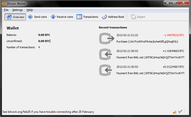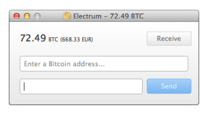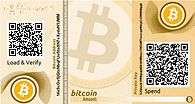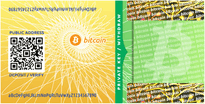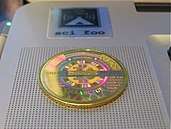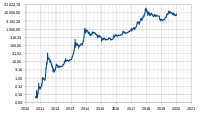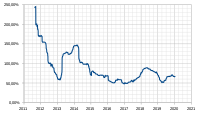Bitcoin
Bitcoin[lower-alpha 1] (₿) is a cryptocurrency invented in 2008 by an unknown person or group of people using the name Satoshi Nakamoto[15] and started in 2009[16] when its implementation was released as open-source software.[9]:ch. 1
| Bitcoin | |
|---|---|
 Prevailing bitcoin logo | |
| Denominations | |
| Plural | bitcoins |
| Symbol | ₿ (Unicode: U+20BF ₿ BITCOIN SIGN (HTML ₿))[lower-alpha 1] |
| Ticker symbol | BTC, XBT[lower-alpha 2] |
| Precision | 10−8 |
| Subunits | |
| 1⁄1000 | millibitcoin |
| 1⁄100000000 | satoshi[2] |
| Development | |
| Original author(s) | Satoshi Nakamoto |
| White paper | "Bitcoin: A Peer-to-Peer Electronic Cash System"[3] |
| Implementation(s) | Bitcoin Core |
| Initial release | 0.1.0 / 9 January 2009 |
| Latest release | 0.20.1 / 2 August 2020[4] |
| Development status | Active |
| Website | bitcoin |
| Ledger | |
| Ledger start | 3 January 2009 |
| Timestamping scheme | Proof-of-work (partial hash inversion) |
| Hash function | SHA-256 |
| Issuance schedule | Decentralized (block reward) Initially ₿50 per block, halved every 210,000 blocks[5][6] |
| Block reward | ₿6.25[lower-alpha 3] |
| Block time | 10 minutes |
| Block explorer | www |
| Circulating supply | ₿18,355,100 (as of 1 May 2020) |
| Supply limit | ₿21,000,000[7][lower-alpha 4] |
| |
It is a decentralized digital currency without a central bank or single administrator that can be sent from user to user on the peer-to-peer bitcoin network without the need for intermediaries.[5] Transactions are verified by network nodes through cryptography and recorded in a public distributed ledger called a blockchain. Bitcoins are created as a reward for a process known as mining. They can be exchanged for other currencies, products, and services.[17] Research produced by University of Cambridge estimates that in 2017, there were 2.9 to 5.8 million unique users using a cryptocurrency wallet, most of them using bitcoin.[18]
Bitcoin has been praised and criticized. Critics noted its use in illegal transactions, the large amount of electricity used by miners, price volatility, and thefts from exchanges. Some economists, including several Nobel laureates, have characterized it as a speculative bubble. Bitcoin has also been used as an investment, although several regulatory agencies have issued investor alerts about bitcoin.[19][20]
History
Creation
The domain name "bitcoin.org" was registered on 18 August 2008.[21] On 31 October 2008, a link to a paper authored by Satoshi Nakamoto titled Bitcoin: A Peer-to-Peer Electronic Cash System[3] was posted to a cryptography mailing list.[22] Nakamoto implemented the bitcoin software as open-source code and released it in January 2009.[23][24][16] Nakamoto's identity remains unknown.[15]
On 3 January 2009, the bitcoin network was created when Nakamoto mined the starting block of the chain, known as the genesis block.[25][26] Embedded in the coinbase of this block was the text "The Times 03/Jan/2009 Chancellor on brink of second bailout for banks".[16] This note references a headline published by The Times and has been interpreted as both a timestamp and a comment on the instability caused by fractional-reserve banking.[27]:18
The receiver of the first bitcoin transaction was cypherpunk Hal Finney, who had created the first reusable proof-of-work system (RPoW) in 2004.[28] Finney downloaded the bitcoin software on its release date, and on 12 January 2009 received ten bitcoins from Nakamoto.[29][30] Other early cypherpunk supporters were creators of bitcoin predecessors: Wei Dai, creator of b-money, and Nick Szabo, creator of bit gold.[25] In 2010, the first known commercial transaction using bitcoin occurred when programmer Laszlo Hanyecz bought two Papa John's pizzas for ₿10,000.[31]
Blockchain analysts estimate that Nakamoto had mined about one million bitcoins[32] before disappearing in 2010, when he handed the network alert key and control of the code repository over to Gavin Andresen. Andresen later became lead developer at the Bitcoin Foundation.[33][34] Andresen then sought to decentralize control. This left opportunity for controversy to develop over the future development path of bitcoin, in contrast to the perceived authority of Nakamoto's contributions.[35][34]
2011–2012
After early "proof-of-concept" transactions, the first major users of bitcoin were black markets, such as Silk Road. During its 30 months of existence, beginning in February 2011, Silk Road exclusively accepted bitcoins as payment, transacting 9.9 million in bitcoins, worth about $214 million.[36]:222
In 2011, the price started at $0.30 per bitcoin, growing to $5.27 for the year. The price rose to $31.50 on 8 June. Within a month the price fell to $11.00. The next month it fell to $7.80, and in another month to $4.77.[37]
In 2012, bitcoin prices started at $5.27 growing to $13.30 for the year.[37] By 9 January the price had risen to $7.38, but then crashed by 49% to $3.80 over the next 16 days. The price then rose to $16.41 on 17 August, but fell by 57% to $7.10 over the next three days.[38]
The Bitcoin Foundation was founded in September 2012 to promote bitcoin's development and uptake.[39]
On 1 November 2011, the reference implementation Bitcoin-Qt version 0.5.0 was released. It introduced a front end that used the Qt user interface toolkit.[40] The software previously used Berkeley DB for database management. Developers switched to LevelDB in release 0.8 in order to reduce blockchain synchronization time. The update to this release resulted in a minor blockchain fork on the 11 March 2013. The fork was resolved shortly afterwards. Seeding nodes through IRC was discontinued in version 0.8.2. From version 0.9.0 the software was renamed to Bitcoin Core. Transaction fees were reduced again by a factor of ten as a means to encourage microtransactions. Although Bitcoin Core does not use OpenSSL for the operation of the network, the software did use OpenSSL for remote procedure calls. Version 0.9.1 was released to remove the network's vulnerability to the Heartbleed bug.
2013–2016
In 2013, prices started at $13.30 rising to $770 by 1 January 2014.[37]
In March 2013 the blockchain temporarily split into two independent chains with different rules due to a bug in version 0.8 of the bitcoin software. The two blockchains operated simultaneously for six hours, each with its own version of the transaction history from the moment of the split. Normal operation was restored when the majority of the network downgraded to version 0.7 of the bitcoin software, selecting the backward-compatible version of the blockchain. As a result, this blockchain became the longest chain and could be accepted by all participants, regardless of their bitcoin software version.[41] During the split, the Mt. Gox exchange briefly halted bitcoin deposits and the price dropped by 23% to $37[41][42] before recovering to previous level of approximately $48 in the following hours.[43]
The US Financial Crimes Enforcement Network (FinCEN) established regulatory guidelines for "decentralized virtual currencies" such as bitcoin, classifying American bitcoin miners who sell their generated bitcoins as Money Service Businesses (MSBs), that are subject to registration or other legal obligations.[44][45][46]
In April, exchanges BitInstant and Mt. Gox experienced processing delays due to insufficient capacity[47] resulting in the bitcoin price dropping from $266 to $76 before returning to $160 within six hours.[48] The bitcoin price rose to $259 on 10 April, but then crashed by 83% to $45 over the next three days.[38]
On 15 May 2013, US authorities seized accounts associated with Mt. Gox after discovering it had not registered as a money transmitter with FinCEN in the US.[49][50] On 23 June 2013, the US Drug Enforcement Administration listed ₿11.02 as a seized asset in a United States Department of Justice seizure notice pursuant to 21 U.S.C. § 881. This marked the first time a government agency had seized bitcoin.[51] The FBI seized about ₿30,000[52] in October 2013 from the dark web website Silk Road, following the arrest of Ross William Ulbricht.[53][54][55] These bitcoins were sold at blind auction by the United States Marshals Service to venture capital investor Tim Draper.[52] Bitcoin's price rose to $755 on 19 November and crashed by 50% to $378 the same day. On 30 November 2013 the price reached $1,163 before starting a long-term crash, declining by 87% to $152 in January 2015.[38]
On 5 December 2013, the People's Bank of China prohibited Chinese financial institutions from using bitcoins.[56] After the announcement, the value of bitcoins dropped,[57] and Baidu no longer accepted bitcoins for certain services.[58] Buying real-world goods with any virtual currency had been illegal in China since at least 2009.[59]
In 2014, prices started at $770 and fell to $314 for the year.[37] On 30 July 2014, the Wikimedia Foundation started accepting donations of bitcoin.[60]
In 2015, prices started at $314 and rose to $434 for the year. In 2016, prices rose and climbed up to $998 by 1 January 2017.[37]
Release 0.10 of the software was made public on 16 February 2015. It introduced a consensus library which gave programmers easy access to the rules governing consensus on the network. In version 0.11.2 developers added a new feature which allowed transactions to be made unspendable until a specific time in the future.[61] Bitcoin Core 0.12.1 was released on April 15, 2016 and enabled multiple soft forks to occur concurrently.[62] Around 100 contributors worked on Bitcoin Core 0.13.0 which was released on 23 August 2016.
In July 2016, the CheckSequenceVerify soft fork activated.[63]
In October 2016, Bitcoin Core’s 0.13.1 release featured the "Segwit" soft fork that included a scaling improvement aiming to optimize the bitcoin blocksize. The patch which was originally finalised in April, and 35 developers were engaged to deploy it. This release featured Segregated Witness (SegWit) which aimed to place downward pressure on transaction fees as well as increase the maximum transaction capacity of the network.[64] The 0.13.1 release endured extensive testing and research leading to some delays in its release date. SegWit prevents various forms of transaction malleability.[65]
2017–2019
On 15 July 2017, the controversial Segregated Witness [SegWit] software upgrade was approved ("locked in"). Segwit was intended to support the Lightning Network as well as improve scalability.[66] SegWit was subsequently activated on the network on 24 August 2017. The bitcoin price rose almost 50% in the week following SegWit's approval.[66] On 21 July 2017, bitcoin was trading at $2,748, up 52% from 14 July 2017's $1,835.[66] Supporters of large blocks who were dissatisfied with the activation of SegWit forked the software on 1 August 2017 to create Bitcoin Cash.
Prices started at $998 in 2017 and rose to $13,412.44 on 1 January 2018,[37] after reaching its all-time high of $19,783.06 on 17 December 2017.[67]
China banned trading in bitcoin, with first steps taken in September 2017, and a complete ban that started on 1 February 2018. Bitcoin prices then fell from $9,052 to $6,914 on 5 February 2018.[38] The percentage of bitcoin trading in the Chinese renminbi fell from over 90% in September 2017 to less than 1% in June 2018.[68]
Throughout the rest of the first half of 2018, bitcoin's price fluctuated between $11,480 and $5,848. On 1 July 2018, bitcoin's price was $6,343.[69][70] The price on 1 January 2019 was $3,747, down 72% for 2018 and down 81% since the all-time high.[69][71]
In September 2018, an anonymous party discovered and reported an invalid-block denial-of-server vulnerability to developers of Bitcoin Core, Bitcoin ABC and Bitcoin Unlimited. Further analysis by bitcoin developers showed the issue could also allow the creation of blocks violating the 21 million coin limit and CVE-2018-17144 was assigned and the issue resolved.[72]
Bitcoin prices were negatively affected by several hacks or thefts from cryptocurrency exchanges, including thefts from Coincheck in January 2018, Coinrail and Bithumb in June, and Bancor in July. For the first six months of 2018, $761 million worth of cryptocurrencies was reported stolen from exchanges.[73] Bitcoin's price was affected even though other cryptocurrencies were stolen at Coinrail and Bancor as investors worried about the security of cryptocurrency exchanges.[74][75][76] In September 2019 the Intercontinental Exchange (the owner of the NYSE) began trading of bitcoin futures on its exchange called Bakkt.[77] Bakkt also announced that it would launch options on bitcoin in December 2019.[78] In December 2019 YouTube removed bitcoin and cryptocurrency videos, but later restored the content after judging they had "made the wrong call."[79]
In February 2019, Canadian cryptocurrency exchange Quadriga Fintech Solutions failed with approximately $200 million missing.[80] By June 2019 the price had recovered to $13,000.[81]
2020
According to CoinMetrics and Forbes, on 11 March 281,000 bitcoins were sold by owners who held them for only thirty days. This compared to 4,131 bitcoins that had laid dormant for a year or more indicating that the vast majority of the bitcoin volatility on that day was from recent buyers.[81] During the week of 11 March 2020 as a result of the COVID-19 pandemic cryptocurrency exchange Kraken experienced an 83% increase in the amount of account signups over the week of bitcoin's price collapse, a result of buyers looking to capitalize on the low price.[81]
Design
Units and divisibility
The unit of account of the bitcoin system is a bitcoin. Ticker symbols used to represent bitcoin are BTC[lower-alpha 2] and XBT.[lower-alpha 3][86]:2 Its Unicode character is ₿.[1] Small amounts of bitcoin used as alternative units are millibitcoin (mBTC), and satoshi (sat). Named in homage to bitcoin's creator, a satoshi is the smallest amount within bitcoin representing 0.00000001 bitcoins, one hundred millionth of a bitcoin.[2] A millibitcoin equals 0.001 bitcoins; one thousandth of a bitcoin or 100,000 satoshis.[87]
Blockchain

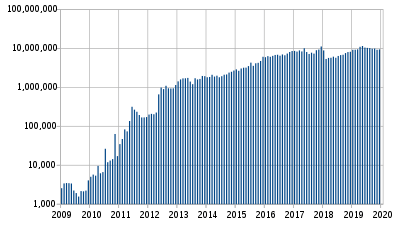
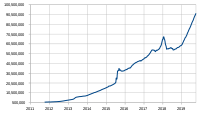
The bitcoin blockchain is a public ledger that records bitcoin transactions.[90] It is implemented as a chain of blocks, each block containing a hash of the previous block up to the genesis block[lower-alpha 4] of the chain. A network of communicating nodes running bitcoin software maintains the blockchain.[36]:215–219 Transactions of the form payer X sends Y bitcoins to payee Z are broadcast to this network using readily available software applications.
Network nodes can validate transactions, add them to their copy of the ledger, and then broadcast these ledger additions to other nodes. To achieve independent verification of the chain of ownership each network node stores its own copy of the blockchain.[91] At varying intervals of time averaging to every 10 minutes, a new group of accepted transactions, called a block, is created, added to the blockchain, and quickly published to all nodes, without requiring central oversight. This allows bitcoin software to determine when a particular bitcoin was spent, which is needed to prevent double-spending. A conventional ledger records the transfers of actual bills or promissory notes that exist apart from it, but the blockchain is the only place that bitcoins can be said to exist in the form of unspent outputs of transactions.[9]:ch. 5
Transactions
Transactions are defined using a Forth-like scripting language.[9]:ch. 5 Transactions consist of one or more inputs and one or more outputs. When a user sends bitcoins, the user designates each address and the amount of bitcoin being sent to that address in an output. To prevent double spending, each input must refer to a previous unspent output in the blockchain.[92] The use of multiple inputs corresponds to the use of multiple coins in a cash transaction. Since transactions can have multiple outputs, users can send bitcoins to multiple recipients in one transaction. As in a cash transaction, the sum of inputs (coins used to pay) can exceed the intended sum of payments. In such a case, an additional output is used, returning the change back to the payer.[92] Any input satoshis not accounted for in the transaction outputs become the transaction fee.[92]
Transaction fees
Though transaction fees are optional, miners can choose which transactions to process and prioritize those that pay higher fees.[92] Miners may choose transactions based on the fee paid relative to their storage size, not the absolute amount of money paid as a fee. These fees are generally measured in satoshis per byte (sat/b). The size of transactions is dependent on the number of inputs used to create the transaction, and the number of outputs.[9]:ch. 8
Ownership
In the blockchain, bitcoins are registered to bitcoin addresses. Creating a bitcoin address requires nothing more than picking a random valid private key and computing the corresponding bitcoin address. This computation can be done in a split second. But the reverse, computing the private key of a given bitcoin address, is practically unfeasible.[9]:ch. 4 Users can tell others or make public a bitcoin address without compromising its corresponding private key. Moreover, the number of valid private keys is so vast that it is extremely unlikely someone will compute a key-pair that is already in use and has funds. The vast number of valid private keys makes it unfeasible that brute force could be used to compromise a private key. To be able to spend their bitcoins, the owner must know the corresponding private key and digitally sign the transaction. The network verifies the signature using the public key; the private key is never revealed.[9]:ch. 5
If the private key is lost, the bitcoin network will not recognize any other evidence of ownership;[36] the coins are then unusable, and effectively lost. For example, in 2013 one user claimed to have lost 7,500 bitcoins, worth $7.5 million at the time, when he accidentally discarded a hard drive containing his private key.[93] About 20% of all bitcoins are believed to be lost. They would have a market value of about $20 billion at July 2018 prices.[94]
To ensure the security of bitcoins, the private key must be kept secret.[9]:ch. 10 If the private key is revealed to a third party, e.g. through a data breach, the third party can use it to steal any associated bitcoins.[95] As of December 2017, around 980,000 bitcoins have been stolen from cryptocurrency exchanges.[96]
Regarding ownership distribution, as of 16 March 2018, 0.5% of bitcoin wallets own 87% of all bitcoins ever mined.[97]
Mining
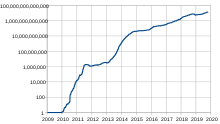
Mining is a record-keeping service done through the use of computer processing power.[lower-alpha 6] Miners keep the blockchain consistent, complete, and unalterable by repeatedly grouping newly broadcast transactions into a block, which is then broadcast to the network and verified by recipient nodes.[90] Each block contains a SHA-256 cryptographic hash of the previous block,[90] thus linking it to the previous block and giving the blockchain its name.[9]:ch. 7[90]
To be accepted by the rest of the network, a new block must contain a proof-of-work (PoW).[90] The system used is based on Adam Back's 1997 anti-spam scheme, Hashcash.[101][3] The PoW requires miners to find a number called a nonce, such that when the block content is hashed along with the nonce, the result is numerically smaller than the network's difficulty target.[9]:ch. 8 This proof is easy for any node in the network to verify, but extremely time-consuming to generate, as for a secure cryptographic hash, miners must try many different nonce values (usually the sequence of tested values is the ascending natural numbers: 0, 1, 2, 3, ...[9]:ch. 8) before meeting the difficulty target.
Every 2,016 blocks (approximately 14 days at roughly 10 min per block), the difficulty target is adjusted based on the network's recent performance, with the aim of keeping the average time between new blocks at ten minutes. In this way the system automatically adapts to the total amount of mining power on the network.[9]:ch. 8 Between 1 March 2014 and 1 March 2015, the average number of nonces miners had to try before creating a new block increased from 16.4 quintillion to 200.5 quintillion.[102]
The proof-of-work system, alongside the chaining of blocks, makes modifications of the blockchain extremely hard, as an attacker must modify all subsequent blocks in order for the modifications of one block to be accepted.[103] As new blocks are mined all the time, the difficulty of modifying a block increases as time passes and the number of subsequent blocks (also called confirmations of the given block) increases.[90]
Supply
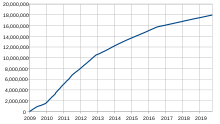
The successful miner finding the new block is allowed by the rest of the network to reward themselves with newly created bitcoins and transaction fees.[104] As of 11 May 2020,[105] the reward amounted to 6.25 newly created bitcoins per block added to the blockchain, plus any transaction fees from payments processed by the block. To claim the reward, a special transaction called a coinbase is included with the processed payments.[9]:ch. 8 All bitcoins in existence have been created in such coinbase transactions. The bitcoin protocol specifies that the reward for adding a block will be halved every 210,000 blocks (approximately every four years). Eventually, the reward will decrease to zero, and the limit of 21 million bitcoins[lower-alpha 7] will be reached c. 2140; the record keeping will then be rewarded solely by transaction fees.[106]
In other words, Nakamoto set a monetary policy based on artificial scarcity at bitcoin's inception that the total number of bitcoins could never exceed 21 million. New bitcoins are created roughly every ten minutes and the rate at which they are generated drops by half about every four years until all will be in circulation.[107]
Pooled mining
Computing power is often bundled together or "pooled" to reduce variance in miner income. Individual mining rigs often have to wait for long periods to confirm a block of transactions and receive payment. In a pool, all participating miners get paid every time a participating server solves a block. This payment depends on the amount of work an individual miner contributed to help find that block.[108]
Wallets
A wallet stores the information necessary to transact bitcoins. While wallets are often described as a place to hold[109] or store bitcoins, due to the nature of the system, bitcoins are inseparable from the blockchain transaction ledger. A wallet is more correctly defined as something that "stores the digital credentials for your bitcoin holdings" and allows one to access (and spend) them.[9]:ch. 1, glossary Bitcoin uses public-key cryptography, in which two cryptographic keys, one public and one private, are generated.[110] At its most basic, a wallet is a collection of these keys.
There are several modes which wallets can operate in. They have an inverse relationship with regards to trustlessness and computational requirements.
- Full clients verify transactions directly by downloading a full copy of the blockchain (over 150 GB as of January 2018).[111] They are the most secure and reliable way of using the network, as trust in external parties is not required. Full clients check the validity of mined blocks, preventing them from transacting on a chain that breaks or alters network rules.[9]:ch. 1 Because of its size and complexity, downloading and verifying the entire blockchain is not suitable for all computing devices.
- Lightweight clients consult full clients to send and receive transactions without requiring a local copy of the entire blockchain (see simplified payment verification – SPV). This makes lightweight clients much faster to set up and allows them to be used on low-power, low-bandwidth devices such as smartphones. When using a lightweight wallet, however, the user must trust the server to a certain degree, as it can report faulty values back to the user. Lightweight clients follow the longest blockchain and do not ensure it is valid, requiring trust in miners.[112]
Third-party internet services called online wallets offer similar functionality but may be easier to use. In this case, credentials to access funds are stored with the online wallet provider rather than on the user's hardware.[113] As a result, the user must have complete trust in the online wallet provider. A malicious provider or a breach in server security may cause entrusted bitcoins to be stolen. An example of such a security breach occurred with Mt. Gox in 2011.[114]
Physical wallets
Physical wallets store the credentials necessary to spend bitcoins offline and can be as simple as a paper printout of the private key:[9]:ch. 10 a paper wallet. A paper wallet is created with a keypair generated on a computer with no internet connection; the private key is written or printed onto the paper[lower-alpha 8] and then erased from the computer. The paper wallet can then be stored in a safe physical location for later retrieval. Bitcoins stored using a paper wallet are said to be in cold storage.[115]:39
Cameron and Tyler Winklevoss, the founders of the Gemini Trust Co. exchange, reported that they had cut their paper wallets into pieces and stored them in envelopes distributed to safe deposit boxes across the United States.[116] Through this system, the theft of one envelope would neither allow the thief to steal any bitcoins nor deprive the rightful owners of their access to them.[117]
Physical wallets can also take the form of metal token coins[118] with a private key accessible under a security hologram in a recess struck on the reverse side.[119]:38 The security hologram self-destructs when removed from the token, showing that the private key has been accessed.[120] Originally, these tokens were struck in brass and other base metals, but later used precious metals as bitcoin grew in value and popularity.[119]:80 Coins with stored face value as high as ₿1000 have been struck in gold.[119]:102–104 The British Museum's coin collection includes four specimens from the earliest series[119]:83 of funded bitcoin tokens; one is currently on display in the museum's money gallery.[121] In 2013, a Utahn manufacturer of these tokens was ordered by the Financial Crimes Enforcement Network (FinCEN) to register as a money services business before producing any more funded bitcoin tokens.[118][119]:80
Another type of physical wallet called a hardware wallet keeps credentials offline while facilitating transactions.[122] The hardware wallet acts as a computer peripheral and signs transactions as requested by the user, who must press a button on the wallet to confirm that they intended to make the transaction. Hardware wallets never expose their private keys, keeping bitcoins in cold storage even when used with computers that may be compromised by malware.[115]:42–45
Implementations
The first wallet program, simply named Bitcoin, and sometimes referred to as the Satoshi client, was released in 2009 by Satoshi Nakamoto as open-source software.[16] In version 0.5 the client moved from the wxWidgets user interface toolkit to Qt, and the whole bundle was referred to as Bitcoin-Qt.[123] After the release of version 0.9, the software bundle was renamed Bitcoin Core to distinguish itself from the underlying network.[124][125]
Forks
Bitcoin Core is, perhaps, the best known implementation or client. Alternative clients (forks of Bitcoin Core) exist, such as Bitcoin XT, Bitcoin Unlimited,[35] and Parity Bitcoin.[126]
On 1 August 2017, Bitcoin Cash was created as result of a hard fork.[127] Bitcoin Cash has a larger block size limit and had an identical blockchain at the time of fork. On 24 October 2017 another hard fork, Bitcoin Gold, was created. Bitcoin Gold changes the proof-of-work algorithm used in mining, as the developers felt that mining had become too specialized.[128]
Decentralization
Bitcoin is decentralized:[5]
- Bitcoin does not have a central authority.[5]
- There is no central server; the bitcoin network is peer-to-peer.[16]
- There is no central storage; the bitcoin ledger is distributed.[129]
- The ledger is public; anybody can store it on their computer.[9]:ch. 1
- There is no single administrator;[5] the ledger is maintained by a network of equally privileged miners.[9]:ch. 1
- Anybody can become a miner.[9]:ch. 1
- The additions to the ledger are maintained through competition. Until a new block is added to the ledger, it is not known which miner will create the block.[9]:ch. 1
- The issuance of bitcoins is decentralized. They are issued as a reward for the creation of a new block.[104]
- Anybody can create a new bitcoin address (a bitcoin counterpart of a bank account) without needing any approval.[9]:ch. 1
- Anybody can send a transaction to the network without needing any approval; the network merely confirms that the transaction is legitimate.[130]:32
Trend towards centralization
Researchers have pointed out at a "trend towards centralization". Although bitcoin can be sent directly from user to user, in practice intermediaries are widely used.[36]:220–222 Bitcoin miners join large mining pools to minimize the variance of their income.[36]:215, 219–222[131]:3[132] Because transactions on the network are confirmed by miners, decentralization of the network requires that no single miner or mining pool obtains 51% of the hashing power, which would allow them to double-spend coins, prevent certain transactions from being verified and prevent other miners from earning income.[133] As of 2013 just six mining pools controlled 75% of overall bitcoin hashing power.[133] In 2014 mining pool Ghash.io obtained 51% hashing power which raised significant controversies about the safety of the network. The pool has voluntarily capped their hashing power at 39.99% and requested other pools to act responsibly for the benefit of the whole network.[134] c. 2017 over 70% of the hashing power and 90% of transactions were operating from China.[135]
According to researchers, other parts of the ecosystem are also "controlled by a small set of entities", notably the maintenance of the client software, online wallets and simplified payment verification (SPV) clients.[133]
Privacy
Bitcoin is pseudonymous, meaning that funds are not tied to real-world entities but rather bitcoin addresses. Owners of bitcoin addresses are not explicitly identified, but all transactions on the blockchain are public. In addition, transactions can be linked to individuals and companies through "idioms of use" (e.g., transactions that spend coins from multiple inputs indicate that the inputs may have a common owner) and corroborating public transaction data with known information on owners of certain addresses.[136] Additionally, bitcoin exchanges, where bitcoins are traded for traditional currencies, may be required by law to collect personal information.[137] To heighten financial privacy, a new bitcoin address can be generated for each transaction.[138]
Fungibility
Wallets and similar software technically handle all bitcoins as equivalent, establishing the basic level of fungibility. Researchers have pointed out that the history of each bitcoin is registered and publicly available in the blockchain ledger, and that some users may refuse to accept bitcoins coming from controversial transactions, which would harm bitcoin's fungibility.[139] For example, in 2012, Mt. Gox froze accounts of users who deposited bitcoins that were known to have just been stolen.[140]
Scalability
The blocks in the blockchain were originally limited to 32 megabytes in size. The block size limit of one megabyte was introduced by Satoshi Nakamoto in 2010. Eventually the block size limit of one megabyte created problems for transaction processing, such as increasing transaction fees and delayed processing of transactions.[141] Andreas Antonopoulos has stated Lightning Network is a potential scaling solution and referred to lightning as a second layer routing network.[9]:ch. 8
Ideology
Satoshi Nakamoto stated in his white paper that: "The root problem with conventional currencies is all the trust that's required to make it work. The central bank must be trusted not to debase the currency, but the history of fiat currencies is full of breaches of that trust."[142]
Austrian economics roots
According to the European Central Bank, the decentralization of money offered by bitcoin has its theoretical roots in the Austrian school of economics, especially with Friedrich von Hayek in his book Denationalisation of Money: The Argument Refined,[143] in which Hayek advocates a complete free market in the production, distribution and management of money to end the monopoly of central banks.[144]:22
Anarchism and libertarianism
According to The New York Times, libertarians and anarchists were attracted to the idea. Early bitcoin supporter Roger Ver said: "At first, almost everyone who got involved did so for philosophical reasons. We saw bitcoin as a great idea, as a way to separate money from the state."[142] The Economist describes bitcoin as "a techno-anarchist project to create an online version of cash, a way for people to transact without the possibility of interference from malicious governments or banks".[145] Economist Paul Krugman argues that cryptocurrencies like bitcoin are "something of a cult" based in "paranoid fantasies" of government power.[146]
| External video | |
|---|---|
Nigel Dodd argues in The Social Life of Bitcoin that the essence of the bitcoin ideology is to remove money from social, as well as governmental, control.[148] Dodd quotes a YouTube video, with Roger Ver, Jeff Berwick, Charlie Shrem, Andreas Antonopoulos, Gavin Wood, Trace Meyer and other proponents of bitcoin reading The Declaration of Bitcoin's Independence. The declaration includes a message of crypto-anarchism with the words: "Bitcoin is inherently anti-establishment, anti-system, and anti-state. Bitcoin undermines governments and disrupts institutions because bitcoin is fundamentally humanitarian."[148][147]
David Golumbia says that the ideas influencing bitcoin advocates emerge from right-wing extremist movements such as the Liberty Lobby and the John Birch Society and their anti-Central Bank rhetoric, or, more recently, Ron Paul and Tea Party-style libertarianism.[149] Steve Bannon, who owns a "good stake" in bitcoin, considers it to be "disruptive populism. It takes control back from central authorities. It's revolutionary."[150]
A 2014 study of Google Trends data found correlations between bitcoin-related searches and ones related to computer programming and illegal activity, but not libertarianism or investment topics.[151]
Economics
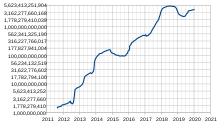
Bitcoin is a digital asset designed to work in peer-to-peer transactions as a currency.[3][152] Bitcoins have three qualities useful in a currency, according to The Economist in January 2015: they are "hard to earn, limited in supply and easy to verify."[153] Per some researchers, as of 2015, bitcoin functions more as a payment system than as a currency.[36]
Economists define money as serving the following three purposes: a store of value, a medium of exchange, and a unit of account.[154] According to The Economist in 2014, bitcoin functions best as a medium of exchange.[154] However, this is debated, and a 2018 assessment by The Economist stated that cryptocurrencies met none of these three criteria.[145] Yale economist Robert J. Shiller writes that bitcoin has potential as a unit of account for measuring the relative value of goods, as with Chile's Unidad de Fomento, but that "Bitcoin in its present form [...] doesn’t really solve any sensible economic problem".[155]
According to research by Cambridge University, between 2.9 million and 5.8 million unique users used a cryptocurrency wallet in 2017, most of them for bitcoin. The number of users has grown significantly since 2013, when there were 300,000–1.3 million users.[18]
Acceptance by merchants
The overwhelming majority of bitcoin transactions take place on a cryptocurrency exchange, rather than being used in transactions with merchants.[156] Delays processing payments through the blockchain of about ten minutes make bitcoin use very difficult in a retail setting. Prices are not usually quoted in units of bitcoin and many trades involve one, or sometimes two, conversions into conventional currencies.[36] Merchants that do accept bitcoin payments may use payment service providers to perform the conversions.[157]
In 2017 and 2018 bitcoin's acceptance among major online retailers included only three of the top 500 U.S. online merchants, down from five in 2016.[156] Reasons for this decline include high transaction fees due to bitcoin's scalability issues and long transaction times.[158]
Bloomberg reported that the largest 17 crypto merchant-processing services handled $69 million in June 2018, down from $411 million in September 2017. Bitcoin is "not actually usable" for retail transactions because of high costs and the inability to process chargebacks, according to Nicholas Weaver, a researcher quoted by Bloomberg. High price volatility and transaction fees make paying for small retail purchases with bitcoin impractical, according to economist Kim Grauer. However, bitcoin continues to be used for large-item purchases on sites such as Overstock.com, and for cross-border payments to freelancers and other vendors.[159]
Financial institutions
Bitcoins can be bought on digital currency exchanges.
Per researchers, "there is little sign of bitcoin use" in international remittances despite high fees charged by banks and Western Union who compete in this market.[36] The South China Morning Post, however, mentions the use of bitcoin by Hong Kong workers to transfer money home.[160]
In 2014, the National Australia Bank closed accounts of businesses with ties to bitcoin,[161] and HSBC refused to serve a hedge fund with links to bitcoin.[162] Australian banks in general have been reported as closing down bank accounts of operators of businesses involving the currency.[163]
On 10 December 2017, the Chicago Board Options Exchange started trading bitcoin futures,[164] followed by the Chicago Mercantile Exchange, which started trading bitcoin futures on 17 December 2017.[165]
In September 2019 the Central Bank of Venezuela, at the request of PDVSA, ran tests to determine if bitcoin and ether could be held in central bank's reserves. The request was motivated by oil company's goal to pay its suppliers.[166]
As an investment
The Winklevoss twins have purchased bitcoin. In 2013, The Washington Post reported a claim that they owned 1% of all the bitcoins in existence at the time.[167]
Other methods of investment are bitcoin funds. The first regulated bitcoin fund was established in Jersey in July 2014 and approved by the Jersey Financial Services Commission.[168]
Forbes named bitcoin the best investment of 2013.[169] In 2014, Bloomberg named bitcoin one of its worst investments of the year.[170] In 2015, bitcoin topped Bloomberg's currency tables.[171]
According to bitinfocharts.com, in 2017 there are 9,272 bitcoin wallets with more than $1 million worth of bitcoins.[172] The exact number of bitcoin millionaires is uncertain as a single person can have more than one bitcoin wallet.
Venture capital
Peter Thiel's Founders Fund invested US$3 million in BitPay.[173] In 2012, an incubator for bitcoin-focused start-ups was founded by Adam Draper, with financing help from his father, venture capitalist Tim Draper, one of the largest bitcoin holders after winning an auction of 30,000 bitcoins,[174] at the time called "mystery buyer".[175] The company's goal is to fund 100 bitcoin businesses within 2–3 years with $10,000 to $20,000 for a 6% stake.[174] Investors also invest in bitcoin mining.[176] According to a 2015 study by Paolo Tasca, bitcoin startups raised almost $1 billion in three years (Q1 2012 – Q1 2015).[177]
Price and volatility
The price of bitcoins has gone through cycles of appreciation and depreciation referred to by some as bubbles and busts.[178] In 2011, the value of one bitcoin rapidly rose from about US$0.30 to US$32 before returning to US$2.[179] In the latter half of 2012 and during the 2012–13 Cypriot financial crisis, the bitcoin price began to rise,[180] reaching a high of US$266 on 10 April 2013, before crashing to around US$50. On 29 November 2013, the cost of one bitcoin rose to a peak of US$1,242.[181] In 2014, the price fell sharply, and as of April remained depressed at little more than half 2013 prices. As of August 2014 it was under US$600.[182]
According to Mark T. Williams, as of 30 September 2014, bitcoin has volatility seven times greater than gold, eight times greater than the S&P 500, and 18 times greater than the US dollar.[183]
Legal status, tax and regulation
Because of bitcoin's decentralized nature and its trading on online exchanges located in many countries, regulation of bitcoin has been difficult. However, the use of bitcoin can be criminalized, and shutting down exchanges and the peer-to-peer economy in a given country would constitute a de facto ban.[184] The legal status of bitcoin varies substantially from country to country and is still undefined or changing in many of them. Regulations and bans that apply to bitcoin probably extend to similar cryptocurrency systems.[185]
According to the Library of Congress, an "absolute ban" on trading or using cryptocurrencies applies in nine countries: Algeria, Bolivia, Egypt, Iraq, Morocco, Nepal, Pakistan, Vietnam, and the United Arab Emirates. An "implicit ban" applies in another 15 countries, which include Bahrain, Bangladesh, China, Colombia, the Dominican Republic, Indonesia, Iran, Kuwait, Lesotho, Lithuania, Macau, Oman, Qatar, Saudi Arabia and Taiwan.[186]
Regulatory warnings
The U.S. Commodity Futures Trading Commission has issued four "Customer Advisories" for bitcoin and related investments.[19] A July 2018 warning emphasized that trading in any cryptocurrency is often speculative, and there is a risk of theft from hacking, and fraud.[187] In May 2014 the U.S. Securities and Exchange Commission warned that investments involving bitcoin might have high rates of fraud, and that investors might be solicited on social media sites.[188] An earlier "Investor Alert" warned about the use of bitcoin in Ponzi schemes.[189]
The European Banking Authority issued a warning in 2013 focusing on the lack of regulation of bitcoin, the chance that exchanges would be hacked, the volatility of bitcoin's price, and general fraud.[190] FINRA and the North American Securities Administrators Association have both issued investor alerts about bitcoin.[191][192]
Price manipulation investigation
An official investigation into bitcoin traders was reported in May 2018.[193] The U.S. Justice Department launched an investigation into possible price manipulation, including the techniques of spoofing and wash trades.[194][195][196]
The U.S. federal investigation was prompted by concerns of possible manipulation during futures settlement dates. The final settlement price of CME bitcoin futures is determined by prices on four exchanges, Bitstamp, Coinbase, itBit and Kraken. Following the first delivery date in January 2018, the CME requested extensive detailed trading information but several of the exchanges refused to provide it and later provided only limited data. The Commodity Futures Trading Commission then subpoenaed the data from the exchanges.[197][198]
State and provincial securities regulators, coordinated through the North American Securities Administrators Association, are investigating "bitcoin scams" and ICOs in 40 jurisdictions.[199]
Academic research published in the Journal of Monetary Economics concluded that price manipulation occurred during the Mt Gox bitcoin theft and that the market remains vulnerable to manipulation.[200] The history of hacks, fraud and theft involving bitcoin dates back to at least 2011.[201]
Research by John M. Griffin and Amin Shams in 2018 suggests that trading associated with increases in the amount of the Tether cryptocurrency and associated trading at the Bitfinex exchange account for about half of the price increase in bitcoin in late 2017.[202][203]
J.L. van der Velde, CEO of both Bitfinex and Tether, denied the claims of price manipulation: "Bitfinex nor Tether is, or has ever, engaged in any sort of market or price manipulation. Tether issuances cannot be used to prop up the price of bitcoin or any other coin/token on Bitfinex."[204]
Criticism
| External video | |
|---|---|
The Bank for International Settlements summarized several criticisms of bitcoin in Chapter V of their 2018 annual report. The criticisms include the lack of stability in bitcoin's price, the high energy consumption, high and variable transactions costs, the poor security and fraud at cryptocurrency exchanges, vulnerability to debasement (from forking), and the influence of miners.[205][206][207]
The Economist describes these criticisms as unfair, predominantly because the shady image may compel users to overlook the capabilities of the blockchain technology, but also due to the fact that the volatility of bitcoin is changing in time.[208]
As a speculative bubble
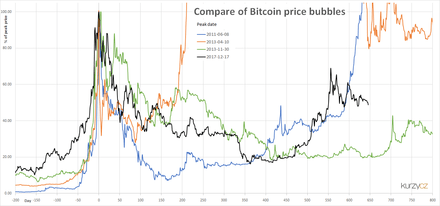
Bitcoin, along with other cryptocurrencies, has been described as an economic bubble by at least eight Nobel Memorial Prize in Economic Sciences laureates, including Robert Shiller,[155] Joseph Stiglitz,[209] and Richard Thaler.[210][211] Noted Keynesian economist Paul Krugman has described bitcoin as "a bubble wrapped in techno-mysticism inside a cocoon of libertarian ideology",[146] professor Nouriel Roubini of New York University has called bitcoin the "mother of all bubbles",[212] and University of Chicago economist James Heckman has compared it to the 17th-century tulip mania.[211]
Alan Greenspan and George Soros both referred to it as a "bubble".[213][214] Warren Buffett called bitcoin a "mirage".[215]
Energy consumption
Bitcoin has been criticized for the amount of electricity consumed by mining. As of 2015, The Economist estimated that even if all miners used modern facilities, the combined electricity consumption would be 166.7 megawatts (1.46 terawatt-hours per year).[153] At the end of 2017, the global bitcoin mining activity was estimated to consume between one and four gigawatts of electricity.[216] By 2018, bitcoin was estimated by Joule[217] to use 2.55 GW, while Environmental Science & Technology[218] estimated bitcoin to consume 3.572 GW (31.29 TWh for the year). In July 2019 BBC reported bitcoin consumes about 7 gigawatts, 0.2% of the global total, or equivalent to that of Switzerland.[219]
According to Politico, even the high-end estimates of bitcoin's total consumption levels amount to only about 6% of the total power consumed by the global banking sector, and even if bitcoin's consumption levels increased 100 fold from today's levels, bitcoin's consumption would still only amount to about 2% of global power consumption.[220]
To lower the costs, bitcoin miners have set up in places like Iceland where geothermal energy is cheap and cooling Arctic air is free.[221] Bitcoin miners are known to use hydroelectric power in Tibet, Quebec, Washington (state), and Austria to reduce electricity costs.[220][222] Miners are attracted to suppliers such as Hydro Quebec that have energy surpluses.[223] According to a University of Cambridge study, much of bitcoin mining is done in China, where electricity is subsidized by the government.[224][225]
Carbon footprint
Concerns about bitcoin's environmental impact relate bitcoin's energy consumption to carbon emissions.[226][227] The difficulty of translating the energy consumption into carbon emissions lies in the decentralized nature of bitcoin impeding the localization of miners to examine the electricity mix used. The results of recent studies analyzing bitcoin's carbon footprint vary.[228][229][230][231] A study published in Nature Climate Change in 2018 claims that bitcoin "could alone produce enough CO
2 emissions to push warming above 2 °C within less than three decades."[230] However, this analysis is subject to strong criticism as the underlying scenarios are considered as inadequate, leading to overestimations.[232][233][234] According to studies published in Joule and American Chemical Society in 2019, bitcoin's annual energy consumption results in annual carbon emission ranging from 17[218] to 22.9 MtCO
2 which is comparable to the level of emissions of countries as Jordan and Sri Lanka or Kansas City.[231] International Energy Agency estimates bitcoin's annual carbon emissions to be in a range from 10 to 20 MtCO
2 and characterizes the predictions in Nature Climate Change as just "sensational predictions about bitcoin" echoing the warnings from late 1990s about Internet and its increasing energy consumption.[235]
Ponzi scheme and pyramid scheme concerns
Journalists, economists, investors, and the central bank of Estonia have voiced concerns that bitcoin is a Ponzi scheme.[236][237][238][239] In April 2013, Eric Posner, a law professor at the University of Chicago, stated that "a real Ponzi scheme takes fraud; bitcoin, by contrast, seems more like a collective delusion."[240] A July 2014 report by the World Bank concluded that bitcoin was not a deliberate Ponzi scheme.[241]:7 In June 2014, the Swiss Federal Council[242]:21 examined the concerns that bitcoin might be a pyramid scheme; it concluded that, "Since in the case of bitcoin the typical promises of profits are lacking, it cannot be assumed that bitcoin is a pyramid scheme."
Security issues
Bitcoin is vulnerable to theft through phishing, scamming, and hacking. As of December 2017, around 980,000 bitcoins have been stolen from cryptocurrency exchanges.[96]
Use in illegal transactions
The use of bitcoin by criminals has attracted the attention of financial regulators, legislative bodies, law enforcement, and the media.[243] Bitcoin gained early notoriety for its use on the Silk Road. The U.S. Senate held a hearing on virtual currencies in November 2013.[244] The U.S. government claimed that bitcoin was used to facilitate payments related to Russian interference in the 2016 United States elections.[245]
Several news outlets have asserted that the popularity of bitcoins hinges on the ability to use them to purchase illegal goods.[152][246] Nobel-prize winning economist Joseph Stiglitz says that bitcoin's anonymity encourages money laundering and other crimes.[247][248]
In 2014, researchers at the University of Kentucky found "robust evidence that computer programming enthusiasts and illegal activity drive interest in bitcoin, and find limited or no support for political and investment motives".[151] Australian researchers have estimated that 25% of all bitcoin users and 44% of all bitcoin transactions are associated with illegal activity as of April 2017. There were an estimated 24 million bitcoin users primarily using bitcoin for illegal activity. They held $8 billion worth of bitcoin, and made 36 million transactions valued at $72 billion.[249][250]
Other critical opinions
François R. Velde, Senior Economist at the Chicago Fed, described it as "an elegant solution to the problem of creating a digital currency".[251]
David Andolfatto, Vice President at the Federal Reserve Bank of St. Louis, stated that bitcoin is a threat to the establishment, which he argues is a good thing for the Federal Reserve System and other central banks, because it prompts these institutions to operate sound policies.[100]:33[252][253]
PayPal President David A. Marcus calls bitcoin a "great place to put assets".[254]
Implementation in software
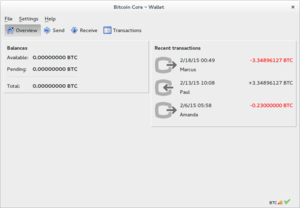 The start screen under Fedora | |
| Original author(s) | Satoshi Nakamoto |
|---|---|
| Initial release | 2009 |
| Stable release | 0.20.0 (3 June 2020) [±] |
| Repository | github |
| Written in | C++ |
| Operating system | Linux, Windows, macOS |
| Type | Cryptocurrency |
| License | MIT License |
| Website | bitcoincore |
Bitcoin Core is free and open-source software that serves as a bitcoin node (the set of which form the bitcoin network) and provides a bitcoin wallet which fully verifies payments. It is considered to be bitcoin's reference implementation.[255] Initially, the software was published by Satoshi Nakamoto under the name "Bitcoin", and later renamed to "Bitcoin Core" to distinguish it from the network.[256] It is also known as the Satoshi client.[257]
The MIT Digital Currency Initiative funds some of the development of Bitcoin Core.[258] The project also maintains the cryptography library libsecp256k1.[259]
Features
Bitcoin Core includes a transaction verification engine and connects to the bitcoin network as a full node.[257] Moreover, a cryptocurrency wallet, which can be used to transfer funds, is included by default.[259] The wallet allows for the sending and receiving of bitcoins. It does not facilitate the buying or selling of bitcoin. It allows users to generate QR codes to receive payment.
The software validates the entire blockchain, which includes all bitcoin transactions ever. This distributed ledger which has reached more than 235 gigabytes in size as of Jan 2019, must be downloaded or synchronized before full participation of the client may occur.[257] Although the complete blockchain is not needed all at once since it is possible to run in pruning mode. A command line-based daemon with a JSON-RPC interface, bitcoind, is bundled with Bitcoin Core. It also provides access to testnet, a global testing environment that imitates the bitcoin main network using an alternative blockchain where valueless "test bitcoins" are used. Regtest or Regression Test Mode creates a private blockchain which is used as a local testing environment.[260] Finally, bitcoin-cli, a simple program which allows users to send RPC commands to bitcoind, is also included.
Checkpoints which have been hard coded into the client are used only to prevent Denial of Service attacks against nodes which are initially syncing the chain. For this reason the checkpoints included are only as of several years ago.[261][262] A one megabyte block size limit was added in 2010 by Satoshi Nakamoto. This limited the maximum network capacity to about three transactions per second.[263] Since then, network capacity has been improved incrementally both through block size increases and improved wallet behavior. A network alert system was included by Satoshi Nakamoto as a way of informing users of important news regarding bitcoin.[264] In November 2016 it was retired. It had become obsolete as news on bitcoin is now widely disseminated.
Bitcoin Core includes a scripting language inspired by Forth that can define transactions and specify parameters.[265] ScriptPubKey is used to "lock" transactions based on a set of future conditions. scriptSig is used to meet these conditions or "unlock" a transaction. Operations on the data are performed by various OP_Codes. Two stacks are used - main and alt. Looping is forbidden.
Bitcoin Core uses OpenTimestamps to timestamp merge commits.[266]
Development
The original creator of the bitcoin client has described their approach to the software's authorship as it being written first to prove to themselves that the concept of purely peer-to-peer electronic cash was valid and that a paper with solutions could be written. The lead developer is Wladimir J. van der Laan, who took over the role on 8 April 2014.[267] Gavin Andresen was the former lead maintainer for the software client. Andresen left the role of lead developer for bitcoin to work on the strategic development of its technology.[267] Bitcoin Core in 2015 was central to a dispute with Bitcoin XT, a competing client that sought to increase the blocksize.[268] Over a dozen different companies and industry groups fund the development of Bitcoin Core.
In popular culture
Literature
In Charles Stross' 2013 science fiction novel, Neptune's Brood, the universal interstellar payment system is known as "bitcoin" and operates using cryptography.[269] Stross later blogged that the reference was intentional, saying "I wrote Neptune's Brood in 2011. Bitcoin was obscure back then, and I figured had just enough name recognition to be a useful term for an interstellar currency: it'd clue people in that it was a networked digital currency."[270]
Film
The 2014 documentary The Rise and Rise of Bitcoin portrays the diversity of motives behind the use of bitcoin by interviewing people who use it. These include a computer programmer and a drug dealer.[271] The 2016 documentary Banking on Bitcoin is an introduction to the beginnings of bitcoin and the ideas behind cryptocurrency today.[272]
Academia
In September 2015, the establishment of the peer-reviewed academic journal Ledger (ISSN 2379-5980) was announced. It covers studies of cryptocurrencies and related technologies, and is published by the University of Pittsburgh.[273] The journal encourages authors to digitally sign a file hash of submitted papers, which will then be timestamped into the bitcoin blockchain. Authors are also asked to include a personal bitcoin address in the first page of their papers.[274][275]
See also
- Alternative currency
- Crypto-anarchism
- List of bitcoin companies
- List of bitcoin organizations
- SHA-256 crypto currencies
- Virtual currency law in the United States
Notes
- The word bitcoin first occurred and was defined in the white paper[3] that was published on 31 October 2008.[10] It is a compound of the words bit and coin.[11] There is no uniform convention for bitcoin capitalization. Some sources use Bitcoin, capitalized, to refer to the technology and network and bitcoin, lowercase, to refer to the unit of account.[12] The Wall Street Journal,[13] The Chronicle of Higher Education,[14] and the Oxford English Dictionary[11] advocate use of lowercase bitcoin in all cases, a convention followed throughout this article.
- As of 2014, BTC is a commonly used code.[82] It does not conform to ISO 4217 as BT is the country code of Bhutan, and ISO 4217 requires the first letter used in global commodities to be 'X'.
- As of 2014, XBT, a code that conforms to ISO 4217 though is not officially part of it, is used by Bloomberg L.P.,[83] CNNMoney,[84] and xe.com.[85]
- The genesis block is the block number 0. The timestamp of the block is 2009-01-03 18:15:05. This block is unlike all other blocks in that it does not have a previous block to reference.
- Relative mining difficulty is defined as the ratio of the difficulty target on 9 January 2009 to the current difficulty target.
- It is misleading to think that there is an analogy between gold mining and bitcoin mining. The fact is that gold miners are rewarded for producing gold, while bitcoin miners are not rewarded for producing bitcoins; they are rewarded for their record-keeping services.[100]
- The exact number is 20,999,999.9769 bitcoins.[9]:ch. 8
- The private key can be printed as a series of letters and numbers, a seed phrase, or a 2D barcode. Usually, the public key or bitcoin address is also printed, so that a holder of a paper wallet can check or add funds without exposing the private key to a device.
- Liquidity is estimated by a 365-day running sum of transaction outputs in USD.
- The price of 1 bitcoin in US dollars.
References
- "Unicode 10.0.0". Unicode Consortium. 20 June 2017. Archived from the original on 20 June 2017. Retrieved 20 June 2017.
- Jason Mick (12 June 2011). "Cracking the Bitcoin: Digging Into a $131M USD Virtual Currency". Daily Tech. Archived from the original on 20 January 2013. Retrieved 30 September 2012.
- Nakamoto, Satoshi (31 October 2008). "Bitcoin: A Peer-to-Peer Electronic Cash System" (PDF). bitcoin.org. Archived (PDF) from the original on 20 March 2014. Retrieved 28 April 2014.
- "Releases - bitcoin/bitcoin". Retrieved 2 August 2020 – via GitHub.
- "Statement of Jennifer Shasky Calvery, Director Financial Crimes Enforcement Network United States Department of the Treasury Before the United States Senate Committee on Banking, Housing, and Urban Affairs Subcommittee on National Security and International Trade and Finance Subcommittee on Economic Policy" (PDF). fincen.gov. Financial Crimes Enforcement Network. 19 November 2013. Archived (PDF) from the original on 9 October 2016. Retrieved 1 June 2014.
- Empson, Rip (28 March 2013). "Bitcoin: How an Unregulated, Decentralized Virtual Currency Just Became a Billion Dollar Market". TechCrunch. AOL inc. Archived from the original on 9 October 2016. Retrieved 8 October 2016.
- Nakamoto; et al. (1 April 2016). "Bitcoin source code - amount constraints". Archived from the original on 1 July 2018.
- Kettley, Sebastian (21 December 2017). "Bitcoin price: How many bitcoin are there and when will the popular crypto token run out?". Daily Express. Archived from the original on 7 May 2019. Retrieved 6 May 2019.
- Antonopoulos, Andreas M. (April 2014). Mastering Bitcoin: Unlocking Digital Crypto-Currencies. O'Reilly Media. ISBN 978-1-4493-7404-4.
- Vigna, Paul; Casey, Michael J. (January 2015). The Age of Cryptocurrency: How Bitcoin and Digital Money Are Challenging the Global Economic Order (1 ed.). New York: St. Martin's Press. ISBN 978-1-250-06563-6.
- "bitcoin". OxfordDictionaries.com. Archived from the original on 2 January 2015. Retrieved 28 December 2014.
- Bustillos, Maria (2 April 2013). "The Bitcoin Boom". The New Yorker. Condé Nast. Archived from the original on 27 July 2014. Retrieved 22 December 2013.
Standards vary, but there seems to be a consensus forming around Bitcoin, capitalized, for the system, the software, and the network it runs on, and bitcoin, lowercase, for the currency itself.
- Vigna, Paul (3 March 2014). "BitBeat: Is It Bitcoin, or bitcoin? The Orthography of the Cryptography". WSJ. Archived from the original on 19 April 2014. Retrieved 21 April 2014.
- Metcalf, Allan (14 April 2014). "The latest style". Lingua Franca blog. The Chronicle of Higher Education (chronicle.com). Archived from the original on 16 April 2014. Retrieved 19 April 2014.
- S., L. (2 November 2015). "Who is Satoshi Nakamoto?". The Economist. The Economist Newspaper Limited. Archived from the original on 21 August 2016. Retrieved 23 September 2016.
- Davis, Joshua (10 October 2011). "The Crypto-Currency: Bitcoin and its mysterious inventor". The New Yorker. Archived from the original on 1 November 2014. Retrieved 31 October 2014.
- "What is Bitcoin?". CNN Money. Archived from the original on 31 October 2015. Retrieved 16 November 2015.
- Hileman, Garrick; Rauchs, Michel. "Global Cryptocurrency Benchmarking Study" (PDF). Cambridge University. Archived (PDF) from the original on 10 April 2017. Retrieved 14 April 2017.
- "Bitcoin". U.S. Commodity Futures Trading Commission. Archived from the original on 1 July 2018. Retrieved 17 July 2018.
- "SEC.gov | INVESTOR ALERT: BITCOIN AND OTHER VIRTUAL CURRENCY-RELATED INVESTMENTS". www.sec.gov. Archived from the original on 3 June 2019. Retrieved 1 June 2019.
- Bernard, Zoë (2 December 2017). "Everything you need to know about Bitcoin, its mysterious origins, and the many alleged identities of its creator". Business Insider. Archived from the original on 15 June 2018. Retrieved 15 June 2018.
- Finley, Klint (31 October 2018). "After 10 Years, Bitcoin Has Changed Everything—And Nothing". Wired. Archived from the original on 5 November 2018. Retrieved 9 November 2018.
- Nakamoto, Satoshi (3 January 2009). "Bitcoin". Archived from the original on 21 July 2017.
- Nakamoto, Satoshi (9 January 2009). "Bitcoin v0.1 released". Archived from the original on 26 March 2014.
- Wallace, Benjamin (23 November 2011). "The Rise and Fall of Bitcoin". Wired. Archived from the original on 31 October 2013. Retrieved 13 October 2012.
- "Block 0 – Bitcoin Block Explorer". Archived from the original on 15 October 2013.
- Pagliery, Jose (2014). Bitcoin: And the Future of Money. Triumph Books. ISBN 9781629370361. Archived from the original on 21 January 2018. Retrieved 20 January 2018.
- "Here's The Problem with the New Theory That A Japanese Math Professor Is The Inventor of Bitcoin". San Francisco Chronicle. 19 May 2013. Archived from the original on 4 January 2015. Retrieved 24 February 2015.
- Peterson, Andrea (3 January 2014). "Hal Finney received the first Bitcoin transaction. Here's how he describes it". The Washington Post. Archived from the original on 27 February 2015.
- Popper, Nathaniel (30 August 2014). "Hal Finney, Cryptographer and Bitcoin Pioneer, Dies at 58". NYTimes. Archived from the original on 3 September 2014. Retrieved 2 September 2014.
- Kharpal, Arjun (18 June 2018). "Everything you need to know about the blockchain". CNBC. Archived from the original on 13 September 2018. Retrieved 13 September 2018.
- McMillan, Robert. "Who Owns the World's Biggest Bitcoin Wallet? The FBI". Wired. Condé Nast. Archived from the original on 21 October 2016. Retrieved 7 October 2016.
- Simonite, Tom. "Meet Gavin Andresen, the most powerful person in the world of Bitcoin". MIT Technology Review. Retrieved 6 December 2017.
- Odell, Matt (21 September 2015). "A Solution To Bitcoin's Governance Problem". TechCrunch. Archived from the original on 26 January 2016. Retrieved 24 January 2016.
- Vigna, Paul (17 January 2016). "Is Bitcoin Breaking Up?". The Wall Street Journal. Archived from the original on 20 August 2016. Retrieved 8 November 2016.
- Rainer Böhme; Nicolas Christin; Benjamin Edelman; Tyler Moore (2015). "Bitcoin: Economics, Technology, and Governance". Journal of Economic Perspectives. 29 (2): 213–238. doi:10.1257/jep.29.2.213.
- "Bitcoin Historical Prices". OfficialData.org. Archived from the original on 4 July 2018. Retrieved 3 July 2018.
- French, Sally (9 February 2017). "Here's proof that this bitcoin crash is far from the worst the cryptocurrency has seen". Market Watch. Archived from the original on 3 July 2018. Retrieved 3 July 2018.
- Bustillos, Maria (1 April 2013). "The Bitcoin Boom". The New Yorker. Archived from the original on 2 July 2018. Retrieved 30 July 2018.
- "Bitcoin-Qt version 0.5.0 released". Bitcoin Project. 1 November 2011. Retrieved 13 November 2016.
- Lee, Timothy (11 March 2013). "Major glitch in Bitcoin network sparks sell-off; price temporarily falls 23%". arstechnica.com. Archived from the original on 22 April 2013. Retrieved 15 February 2015.
- Blagdon, Jeff (12 March 2013). "Technical problems cause Bitcoin to plummet from record high, Mt. Gox suspends deposits". The Verge. Archived from the original on 22 April 2013. Retrieved 12 March 2013.
- "Bitcoin Charts". Archived from the original on 9 May 2014.
- Lee, Timothy (20 March 2013). "US regulator Bitcoin Exchanges Must Comply With Money Laundering Laws". Arstechnica. Archived from the original on 21 October 2013. Retrieved 28 July 2017.
Bitcoin miners must also register if they trade in their earnings for dollars.
- "US govt clarifies virtual currency regulatory position". Finextra. 19 March 2013. Archived from the original on 26 March 2014.
- "Application of FinCEN's Regulations to Persons Administering, Exchanging, or Using Virtual Currencies" (PDF). Department of the Treasury Financial Crimes Enforcement Network. Archived from the original (PDF) on 28 March 2013. Retrieved 19 March 2013.
- Roose, Kevin (8 April 2013) "Inside the Bitcoin Bubble: BitInstant's CEO – Daily Intelligencer". Archived from the original on 9 April 2014.. Nymag.com. Retrieved on 20 April 2013.
- "Bitcoin Exchange Rate". Bitcoinscharts.com. Archived from the original on 24 June 2012. Retrieved 15 August 2013.
- Dillet, Romain. "Feds Seize Assets From Mt. Gox's Dwolla Account, Accuse It Of Violating Money Transfer Regulations". Archived from the original on 9 October 2013. Retrieved 15 May 2013.
- Berson, Susan A. (2013). "Some basic rules for using 'bitcoin' as virtual money". American Bar Association. Archived from the original on 29 October 2013. Retrieved 26 June 2013.
- Sampson, Tim (2013). "U.S. government makes its first-ever Bitcoin seizure". The Daily Dot. Archived from the original on 30 June 2013. Retrieved 15 October 2013.
- Ember, Sydney (2 July 2014). "Winner of Bitcoin Auction, Tim Draper, Plans to Expand Currency's Use". The New York Times DealBook. Archived from the original on 28 August 2019. Retrieved 13 June 2019.
- "After Silk Road seizure, FBI Bitcoin wallet identified and pranked". Archived from the original on 5 April 2014.
- "Silkroad Seized Coins". Archived from the original on 9 January 2014. Retrieved 2 November 2013.
- Hill, Kashmir. "The FBI's Plan For The Millions Worth Of Bitcoins Seized From Silk Road". Forbes. Archived from the original on 2 May 2014.
- Kelion, Leo (18 December 2013). "Bitcoin sinks after China restricts yuan exchanges". bbc.com. BBC. Archived from the original on 19 December 2013. Retrieved 20 December 2013.
- "China bans banks from bitcoin transactions". The Sydney Morning Herald. Reuters. 6 December 2013. Archived from the original on 23 March 2014. Retrieved 31 October 2014.
- "Baidu Stops Accepting Bitcoins After China Ban". Bloomberg. New York. 7 December 2013. Archived from the original on 10 December 2013. Retrieved 11 December 2013.
- "China bars use of virtual money for trading in real goods". English.mofcom.gov.cn. 29 June 2009. Archived from the original on 29 November 2013. Retrieved 10 January 2014.
- Rayman, Noah (30 July 2014). "You Can Now Donate to Wikipedia in Bitcoin". TIME. Archived from the original on 30 July 2014. Retrieved 27 April 2019.
- "Bitcoin Core version 0.11.2 released". Bitcoin Project. 13 November 2015. Retrieved 14 November 2016.
- Kyle Torpey (15 April 2016). "Bitcoin Core 0.12.1 Released, Major Step Forward for Scalability". Bitcoin Magazine. NASDAQ.com. Retrieved 7 November 2016.
- Antonopoulos, Andreas (2017). Mastering Bitcoin: Programming the Open Blockchain (2nd ed.). O'Reilly Media. ISBN 978-1491954386.
BIP-68 and BIP-112 were activated in May 2016 as a soft fork upgrade to the consensus rules.
- "Bitcoin Core 0.13.1". Bitcoin Core. Retrieved 25 October 2016.
- "Segregated Witness Benefits". Bitcoin Core. 26 January 2016. Retrieved 20 October 2018.
- Vigna, Paul (21 July 2017). "Bitcoin Rallies Sharply After Vote Resolves Bitter Scaling Debate". WSJ. Archived from the original on 26 January 2020. Retrieved 26 January 2020.
- "Bitcoin Hits a New Record High, But Stops Short of $20,000". Fortune. Archived from the original on 14 November 2018. Retrieved 16 April 2019.
- "RMB Bitcoin trading falls below 1 pct of world total". Xinhuanet. Xinhua. 7 July 2018. Archived from the original on 10 July 2018. Retrieved 10 July 2018.
- "Bitcoin USD". Yahoo Finance!. Archived from the original on 28 January 2019. Retrieved 27 January 2019.
- Dawkins, David (10 July 2018). "Has CHINA burst the bitcoin BUBBLE? Trading in RMB drops from 90% to 1%". Express. Archived from the original on 10 July 2018. Retrieved 10 July 2018.
- "Bitcoin turns 10: The obscure technology that became a household name". CNBC. 4 January 2019. Archived from the original on 19 January 2019. Retrieved 18 January 2019.
- "CVE-2018-17144 Full Disclosure". Bitcoin Core. Retrieved 23 September 2018.
- Chavez-Dreyfuss, Gertrude (3 July 2018). "Cryptocurrency exchange theft surges in first half of 2018: report". Reuters. Archived from the original on 4 July 2018. Retrieved 10 July 2018.
- "Cryptocurrencies Tumble After $32 Million South Korea Exchange Hack". Fortune. Bloomberg. 20 July 2018. Archived from the original on 11 July 2018. Retrieved 10 July 2018.
- Shane, Daniel (11 June 2018). "Billions in cryptocurrency wealth wiped out after hack". CNN. Archived from the original on 11 July 2018. Retrieved 10 July 2018.
- Russell, Jon (10 July 2018). "The crypto world's latest hack sees Israel's Bancor lose $23.5M". TechCrunch. Archived from the original on 10 July 2018. Retrieved 10 July 2018.
- Osipovich, Alexander (22 September 2019). "NYSE Owner Launches Long-Awaited Bitcoin Futures". WSJ. Archived from the original on 24 September 2019. Retrieved 24 September 2019.
- Olga Kharif (24 October 2019). "Bakkt Plans First Regulated Options Contracts on Bitcoin Futures". bloomberg.com. Bloomberg. Archived from the original on 24 October 2019. Retrieved 5 November 2019.
- "YouTube admits error over Bitcoin video purge". bbc.com. BBC. 28 December 2019. Archived from the original on 28 December 2019. Retrieved 28 December 2019.
- Alexander, Doug (4 February 2019). "Crypto CEO Dies Holding Only Passwords That Can Unlock Millions in Customer Coins". bloomberg.com. Bloomberg. Archived from the original on 16 December 2019. Retrieved 27 January 2020.
- del Castillo, Michael (19 March 2020). "Bitcoin's Magic Is Fading, And That's A Good Thing". Forbes.com. Forbes. Archived from the original on 20 March 2020. Retrieved 21 March 2020.
- Dellinger, A. J. (15 February 2018). "What Are Cryptocurrency Ticker Symbols? BTC, XRP, ETH And More Explained". International Business Times. Archived from the original on 29 May 2019. Retrieved 29 May 2019.
- Romain Dillet (9 August 2013). "Bitcoin Ticker Available On Bloomberg Terminal For Employees". TechCrunch. Archived from the original on 1 November 2014. Retrieved 2 November 2014.
- "Bitcoin Composite Quote (XBT)". CNN Money. CNN. Archived from the original on 27 October 2014. Retrieved 2 November 2014.
- "XBT – Bitcoin". xe.com. Archived from the original on 2 November 2014. Retrieved 2 November 2014.
- "Regulation of Bitcoin in Selected Jurisdictions" (PDF). The Law Library of Congress, Global Legal Research Center. January 2014. Archived (PDF) from the original on 14 October 2014. Retrieved 26 August 2014.
- Katie Pisa & Natasha Maguder (9 July 2014). "Bitcoin your way to a double espresso". cnn.com. CNN. Archived from the original on 18 June 2015. Retrieved 23 April 2015.
- "Blockchair". Blockchair.com. Archived from the original on 13 October 2019. Retrieved 13 October 2019.
- "Charts". Blockchain.info. Archived from the original on 3 November 2014. Retrieved 2 November 2014.
- "The great chain of being sure about things". The Economist. The Economist Newspaper Limited. 31 October 2015. Archived from the original on 3 July 2016. Retrieved 3 July 2016.
- Sparkes, Matthew (9 June 2014). "The coming digital anarchy". The Telegraph. London: Telegraph Media Group Limited. Archived from the original on 23 January 2015. Retrieved 7 January 2015.
- Joshua A. Kroll; Ian C. Davey; Edward W. Felten (11–12 June 2013). "The Economics of Bitcoin Mining, or Bitcoin in the Presence of Adversaries" (PDF). The Twelfth Workshop on the Economics of Information Security (WEIS 2013). Archived (PDF) from the original on 9 May 2016. Retrieved 26 April 2016.
A transaction fee is like a tip or gratuity left for the miner.
- "Man Throws Away 7,500 Bitcoins, Now Worth $7.5 Million". CBS DC. 29 November 2013. Archived from the original on 15 January 2014. Retrieved 23 January 2014.
- Krause, Elliott (5 July 2018). "A Fifth of All Bitcoin Is Missing. These Crypto Hunters Can Help". Wall Street Journal. Archived from the original on 9 July 2018. Retrieved 8 July 2018.
- Jeffries, Adrianne (19 December 2013). "How to steal Bitcoin in three easy steps". The Verge. Archived from the original on 27 July 2019. Retrieved 17 January 2014.
- Harney, Alexandra; Stecklow, Steve (16 November 2017). "Twice burned - How Mt. Gox's bitcoin customers could lose again". Reuters. Archived from the original on 29 August 2019. Retrieved 6 September 2018.
- Martindale, Jon (16 March 2018). "Who owns all the Bitcoin? A few billionaire whales in a small pond". Digital Trends. Archived from the original on 30 June 2019. Retrieved 1 July 2019.
- "Bitcoin mania is hurting PC gamers by pushing up GPU prices". Archived from the original on 2 February 2018. Retrieved 2 February 2018.
- "Cryptocurrency mining operation launched by Iron Bridge Resources". World Oil. 26 January 2018. Archived from the original on 30 January 2018.
- Andolfatto, David (31 March 2014). "Bitcoin and Beyond: The Possibilities and Pitfalls of Virtual Currencies" (PDF). Dialogue with the Fed. Federal Reserve Bank of St. Louis. Archived (PDF) from the original on 9 April 2014. Retrieved 16 April 2014.
- Sherman, Alan; Javani, Farid; Golaszewski, Enis (25 March 2019). "On the Origins and Variations of Blockchain Technologies". IEEE Security and Policy. 17 (1): 72–77. arXiv:1810.06130. doi:10.1109/MSEC.2019.2893730.
- "Difficulty History" (The ratio of all hashes over valid hashes is D x 4,295,032,833, where D is the published "Difficulty" figure.). Blockchain.info. Archived from the original on 8 April 2015. Retrieved 26 March 2015.
- Hampton, Nikolai (5 September 2016). "Understanding the blockchain hype: Why much of it is nothing more than snake oil and spin". Computerworld. IDG. Archived from the original on 6 September 2016. Retrieved 5 September 2016.
- Ashlee Vance (14 November 2013). "2014 Outlook: Bitcoin Mining Chips, a High-Tech Arms Race". Businessweek. Archived from the original on 21 November 2013. Retrieved 24 November 2013.
- "Block #420000". Blockchain.info. Archived from the original on 18 September 2016. Retrieved 11 September 2016.
- Ritchie S. King; Sam Williams; David Yanofsky (17 December 2013). "By reading this article, you're mining bitcoins". qz.com. Atlantic Media Co. Archived from the original on 17 December 2013. Retrieved 17 December 2013.
- Shin, Laura (24 May 2016). "Bitcoin Production Will Drop By Half In July, How Will That Affect The Price?". Forbes. Archived from the original on 24 May 2016. Retrieved 13 July 2016.
- Biggs, John (8 April 2013). "How To Mine Bitcoins". Techcrunch. Archived from the original on 6 July 2017.
- Adam Serwer & Dana Liebelson (10 April 2013). "Bitcoin, Explained". motherjones.com. Mother Jones. Archived from the original on 27 April 2014. Retrieved 26 April 2014.
- "Bitcoin: Bitcoin under pressure". The Economist. 30 November 2013. Archived from the original on 30 November 2013. Retrieved 30 November 2013.
- "Blockchain Size". Blockchain.info. Archived from the original on 27 May 2017. Retrieved 16 January 2018.
- Gervais, Arthur; O. Karame, Ghassan; Gruber, Damian; Capkun, Srdjan. "On the Privacy Provisions of Bloom Filters in Lightweight Bitcoin Clients" (PDF). Archived (PDF) from the original on 5 October 2016. Retrieved 3 September 2016.
- Bill Barhydt (4 June 2014). "3 reasons Wall Street can't stay away from bitcoin". NBCUniversal. Archived from the original on 3 April 2015. Retrieved 2 April 2015.
- "MtGox gives bankruptcy details". bbc.com. BBC. 4 March 2014. Archived from the original on 12 March 2014. Retrieved 13 March 2014.
- Barski, Conrad; Wilmer, Chris (2015). Bitcoin for the Befuddled. No Starch Press. ISBN 978-1-59327-573-0.
- Popper, Nathaniel (19 December 2017). "How the Winklevoss Twins Found Vindication in a Bitcoin Fortune". The New York Times. Archived from the original on 20 June 2019. Retrieved 19 June 2019.
- Alexander, Doug (15 February 2019). "Quadriga's late founder used to store clients' Bitcoin passwords on paper so they wouldn't get lost". Bloomberg News. Financial Post. Archived from the original on 20 June 2019. Retrieved 19 June 2019.
- Staff, Verge (13 December 2013). "Casascius, maker of shiny physical bitcoins, shut down by Treasury Department". The Verge. Archived from the original on 10 January 2014. Retrieved 10 January 2014.
- Ahonen, Elias; Rippon, Matthew J.; Kesselman, Howard (15 April 2016). Encyclopedia of Physical Bitcoins and Crypto-Currencies. ISBN 978-0-9950-8990-7.
- Mack, Eric (25 October 2011). "Are physical Bitcoins legal?". CNET. Archived from the original on 26 June 2019. Retrieved 19 May 2019.
- British Museum (2012). "Bitcoin token with digital code for bitcoin currency". Retrieved 17 May 2019.
- Roberts, Daniel (15 December 2017). "How to send bitcoin to a hardware wallet". Yahoo Finance. Archived from the original on 17 February 2018. Retrieved 17 February 2018.
- Skudnov, Rostislav (2012). Bitcoin Clients (PDF) (Bachelor's Thesis). Turku University of Applied Sciences. Archived (PDF) from the original on 18 January 2014. Retrieved 16 January 2014.
- "Bitcoin Core version 0.9.0 released". bitcoin.org. Archived from the original on 27 February 2015. Retrieved 8 January 2015.
- Metz, Cade (19 August 2015). "The Bitcoin Schism Shows the Genius of Open Source". Wired. Condé Nast. Archived from the original on 30 June 2016. Retrieved 3 July 2016.
- Allison, Ian (28 April 2017). "Ethereum co-founder Dr Gavin Wood and company release Parity Bitcoin". International Business Times. Archived from the original on 28 April 2017. Retrieved 28 April 2017.
- Selena Larson (1 August 2017). "Bitcoin split in two, here's what that means". CNN Tech. Cable News Network. Archived from the original on 27 February 2018. Retrieved 2 April 2018.
- "Bitcoin Gold, the latest Bitcoin fork, explained". Ars Technica. Archived from the original on 29 December 2017. Retrieved 29 December 2017.
- Meola, Andrew (5 October 2017). "How distributed ledger technology will change the way the world works". Business Insider. Archived from the original on 27 April 2018. Retrieved 26 July 2018.
- Jerry Brito & Andrea Castillo (2013). "Bitcoin: A Primer for Policymakers" (PDF). Mercatus Center. George Mason University. Archived (PDF) from the original on 21 September 2013. Retrieved 22 October 2013.
- Tschorsch, Florian; Scheuermann, Björn (2016). "Bitcoin and Beyond: A Technical Survey on Decentralized Digital Currencies". IEEE Communications Surveys & Tutorials. 18 (3): 2084–2123. doi:10.1109/comst.2016.2535718.
- Beikverdi, A.; Song, J. (June 2015). Trend of centralization in Bitcoin's distributed network. 2015 IEEE/ACIS 16th International Conference on Software Engineering, Artificial Intelligence, Networking and Parallel/Distributed Computing (SNPD). pp. 1–6. doi:10.1109/SNPD.2015.7176229. ISBN 978-1-4799-8676-7.
- Gervais, Arthur; Karame, Ghassan O.; Capkun, Vedran; Capkun, Srdjan. "Is Bitcoin a Decentralized Currency?". InfoQ. InfoQ & IEEE Computer Society. Archived from the original on 10 October 2016. Retrieved 11 October 2016.
- Wilhelm, Alex. "Popular Bitcoin Mining Pool Promises To Restrict Its Compute Power To Prevent Feared '51%' Fiasco". TechCrunch. Archived from the original on 5 December 2017. Retrieved 25 January 2018.
- Chan, Edwin. "China Plans to Ban Cryptocurrency Mining in Renewed Clampdown". www.bloomberg.com. Archived from the original on 18 December 2019. Retrieved 10 April 2019.
While China was once home to about 70 percent of Bitcoin mining and 90 percent of trades, authorities have waged a nearly two-year campaign to shrink the crypto industry amid concerns over speculative bubbles, fraud and wasteful energy consumption.
- Simonite, Tom (5 September 2013). "Mapping the Bitcoin Economy Could Reveal Users' Identities". MIT Technology Review. Retrieved 2 April 2014.
- Lee, Timothy (21 August 2013). "Five surprising facts about Bitcoin". The Washington Post. Archived from the original on 12 October 2013. Retrieved 2 April 2014.
- McMillan, Robert (6 June 2013). "How Bitcoin lets you spy on careless companies". wired.co.uk. Conde Nast. Archived from the original on 9 February 2014. Retrieved 3 April 2020.
- Ben-Sasson, Eli; Chiesa, Alessandro; Garman, Christina; Green, Matthew; Miers, Ian; Tromer, Eran; Virza, Madars (2014). "Zerocash: Decentralized Anonymous Payments from Bitcoin" (PDF). 2014 IEEE Symposium on Security and Privacy. IEEE computer society. Archived (PDF) from the original on 14 October 2014. Retrieved 31 October 2014.
- Möser, Malte; Böhme, Rainer; Breuker, Dominic (2013). An Inquiry into Money Laundering Tools in the Bitcoin Ecosystem (PDF). 2013 APWG eCrime Researchers Summit. IEEE. ISBN 978-1-4799-1158-5. Archived (PDF) from the original on 26 June 2018. Retrieved 19 June 2019.
- Orcutt, Mike (19 May 2015). "Leaderless Bitcoin Struggles to Make Its Most Crucial Decision". MIT Technology Review. Archived from the original on 18 October 2017. Retrieved 22 June 2017.
- Feuer, Alan (14 December 2013). "The Bitcoin Ideology". The New York Times. Archived from the original on 1 July 2018. Retrieved 1 July 2018.
- Friedrich von Hayek (October 1976). Denationalisation of Money: The Argument Refined. 2 Lord North Street, Westminster, London SWIP 3LB: The institute of economic affairs. ISBN 978-0-255-36239-9. Archived from the original on 11 January 2020. Retrieved 10 September 2015.CS1 maint: location (link)
- European Central Bank (October 2012). Virtual Currency Schemes (PDF). Frankfurt am Main: European Central Bank. ISBN 978-92-899-0862-7. Archived (PDF) from the original on 6 November 2012.
- "Bitcoin and other cryptocurrencies are useless". The Economist. 30 August 2018. Archived from the original on 4 September 2018. Retrieved 4 September 2018.
Lack of adoption and loads of volatility mean that cryptocurrencies satisfy none of those criteria.
- Krugman, Paul (29 January 2018). "Bubble, Bubble, Fraud and Trouble". The New York Times. Archived from the original on 4 June 2018.
- Tourianski, Julia. "The Declaration Of Bitcoin's Independence". Archive.org. Archived from the original on 23 March 2019. Retrieved 1 July 2018.
- Dodd, Nigel (2017). "The social life of Bitcoin" (PDF). LSE Research Online. Archived (PDF) from the original on 1 July 2018. Retrieved 1 July 2018.
- Golumbia, David (2015). Lovink, Geert (ed.). Bitcoin as Politics: Distributed Right-Wing Extremism. Institute of Network Cultures, Amsterdam. pp. 117–131. ISBN 978-90-822345-5-8. SSRN 2589890.
- Peters, Jeremy W.; Popper, Nathaniel (14 June 2018). "Stephen Bannon Buys Into Bitcoin". The New York Times. Archived from the original on 1 July 2018. Retrieved 1 July 2018.
- Matthew Graham Wilson & Aaron Yelowitz (November 2014). "Characteristics of Bitcoin Users: An Analysis of Google Search Data". Social Science Research Network. Working Papers Series. SSRN 2518603.
- "Monetarists Anonymous". The Economist. The Economist Newspaper Limited. 29 September 2012. Archived from the original on 20 October 2013. Retrieved 21 October 2013.
- "The magic of mining". The Economist. 13 January 2015. Archived from the original on 12 January 2015. Retrieved 13 January 2015.
- "Free Exchange. Money from nothing. Chronic deflation may keep Bitcoin from displacing its rivals". The Economist. 15 March 2014. Archived from the original on 25 March 2014. Retrieved 25 March 2014.
- Shiller, Robert (1 March 2014). "In Search of a Stable Electronic Currency". The New York Times. Archived from the original on 24 October 2014.
- Murphy, Hannah (8 June 2018). "Who really owns bitcoin now?". Financial Times. Archived from the original on 10 June 2018. Retrieved 10 June 2018.
- Karkaria, Urvaksh (23 September 2014). "Atlanta-based BitPay hooks up with PayPal to expand bitcoin adoption". Atlanta Business Chronicle. Archived from the original on 26 October 2014.
- Katz, Lily (12 July 2017). "Bitcoin Acceptance Among Retailers Is Low and Getting Lower". Bloomberg. Archived from the original on 25 January 2018. Retrieved 25 January 2018.
- Kharif, Olga (1 August 2018). "Bitcoin's Use in Commerce Keeps Falling Even as Volatility Eases". Bloomberg. Archived from the original on 2 August 2018. Retrieved 2 August 2018.
- Chan, Bernice (16 January 2015). "Bitcoin transactions cut the cost of international money transfers". South China Morning Post. Archived from the original on 31 May 2019. Retrieved 31 May 2019.
- "Bitcoin firms dumped by National Australia Bank as 'too risky'". The Guardian. Australian Associated Press. 10 April 2014. Archived from the original on 23 February 2015. Retrieved 23 February 2015.
- Weir, Mike (1 December 2014). "HSBC severs links with firm behind Bitcoin fund". bbc.com. BBC. Archived from the original on 3 February 2015. Retrieved 9 January 2015.
- "ACCC investigating why banks are closing bitcoin companies' accounts". Financial Review. Archived from the original on 11 February 2016. Retrieved 28 January 2016.
- "Bitcoin futures surge in first day of trading". CBS News. 11 December 2017. Archived from the original on 31 May 2019. Retrieved 31 May 2019.
- "Chicago Mercantile Exchange jumps into bitcoin futures". CBS News. 18 December 2017. Archived from the original on 31 May 2019. Retrieved 31 May 2019.
- "Venezuela Has Bitcoin Stash and Doesn't Know What to Do With It". Bloomberg. 26 September 2019. Archived from the original on 26 September 2019. Retrieved 26 September 2019.
- Lee, Timothy B. "The $11 million in bitcoins the Winklevoss brothers bought is now worth $32 million". The Switch. The Washington Post. Archived from the original on 6 July 2017. Retrieved 11 August 2017.
- "Jersey approve Bitcoin fund launch on island". BBC news. 10 July 2014. Archived from the original on 10 July 2014. Retrieved 10 July 2014.
- Hill, Kashmir. "How You Should Have Spent $100 In 2013 (Hint: Bitcoin)". Forbes. Archived from the original on 19 February 2015. Retrieved 16 February 2015.
- Steverman, Ben (23 December 2014). "The Best and Worst Investments of 2014". bloomberg.com. Bloomberg LP. Archived from the original on 9 January 2015. Retrieved 9 January 2015.
- Gilbert, Mark (29 December 2015). "Bitcoin Won 2015. Apple ... Did Not". Bloomberg. Archived from the original on 29 December 2015. Retrieved 29 December 2015.
- "Top 100 Richest Bitcoin Addresses and Bitcoin distribution". bitinfocharts.com. Archived from the original on 15 October 2017. Retrieved 14 October 2017.
- Simonite, Tom (12 June 2013). "Bitcoin Millionaires Become Investing Angels". Computing News. MIT Technology Review. Retrieved 13 June 2013.
- Robin Sidel (1 December 2014). "Ten-hut! Bitcoin Recruits Snap To". Wall Street Journal. Dow Jones & Company. Retrieved 9 December 2014.
- Alex Hern (1 July 2014). "Silk Road's legacy 30,000 bitcoin sold at auction to mystery buyers". The Guardian. Archived from the original on 23 October 2014. Retrieved 31 October 2014.
- "CoinSeed raises $7.5m, invests $5m in Bitcoin mining hardware – Investment Round Up". Red Herring. 24 January 2014. Archived from the original on 9 March 2014. Retrieved 9 March 2014.
- Tasca, Paolo (7 September 2015). "Digital Currencies: Principles, Trends, Opportunities, and Risks". Social Science Research Network. SSRN 2657598. Cite journal requires
|journal=(help) - Moore, Heidi (3 April 2013). "Confused about Bitcoin? It's 'the Harlem Shake of currency'". theguardian.com. The Guardian. Archived from the original on 1 March 2014. Retrieved 2 May 2014.
- Lee, Timothy (5 November 2013). "When will the people who called Bitcoin a bubble admit they were wrong". The Washington Post. Archived from the original on 11 January 2014. Retrieved 10 January 2014.
- Liu, Alec (19 March 2013). "When Governments Take Your Money, Bitcoin Looks Really Good". Motherboard. Archived from the original on 7 February 2014. Retrieved 7 January 2014.
- Ben Rooney (29 November 2013). "Bitcoin worth almost as much as gold". CNN. Archived from the original on 26 October 2014. Retrieved 31 October 2014.
- "Bitcoin prices remain below $600 amid bearish chart signals". nasdaq.com. August 2014. Archived from the original on 14 October 2014. Retrieved 31 October 2014.
- Williams, Mark T. (21 October 2014). "Virtual Currencies – Bitcoin Risk" (PDF). World Bank Conference Washington DC. Boston University. Archived (PDF) from the original on 11 November 2014. Retrieved 11 November 2014.
- "China May Be Gearing Up to Ban Bitcoin". pastemagazine.com. Archived from the original on 3 October 2017. Retrieved 6 October 2017.
The decentralized nature of bitcoin is such that it is impossible to “ban” the cryptocurrency, but if you shut down exchanges and the peer-to-peer economy running on bitcoin, it's a de facto ban.
- Tasca, Paolo (7 September 2015). "Digital Currencies: Principles, Trends, Opportunities, and Risks". Social Science Research Network. SSRN 2657598. Cite journal requires
|journal=(help) - "Regulation of Cryptocurrency Around the World" (PDF). Library of Congress. The Law Library of Congress, Global Legal Research Center. June 2018. pp. 4–5. Archived (PDF) from the original on 14 August 2018. Retrieved 15 August 2018.
- "Customer Advisory: Use Caution When Buying Digital Coins or Tokens" (PDF). U.S.Commodity Futures Trading Commission. Archived (PDF) from the original on 17 July 2018. Retrieved 17 July 2018.
- "Investor Alert: Bitcoin and Other Virtual Currency-related Investments". Investor.gov. U.S. Securities and Exchange Commission. 7 May 2014. Archived from the original on 30 June 2018. Retrieved 17 July 2018.
- "Ponzi schemes Using virtual Currencies" (PDF). sec.gov. U.S. Securities and Exchange Commission. Archived (PDF) from the original on 16 June 2018. Retrieved 17 July 2018.
- "Warning to consumers on virtual currencies" (PDF). European Banking Authority. 12 December 2013. Archived from the original (PDF) on 28 December 2013. Retrieved 23 December 2013.
- "Investor Alerts Don't Fall for Cryptocurrency-Related Stock Scams". FINRA.org. Financial Industry Regulatory Authority. 21 December 2017. Archived from the original on 1 July 2018. Retrieved 23 July 2018.
- "Informed Investor Advisory: Cryptocurrencies". North American Securities Administrators Association. April 2018. Archived from the original on 23 July 2018. Retrieved 23 July 2018.
- Dean, James (25 May 2018). "Bitcoin investigation to focus on British traders, US officials examine manipulation of cryptocurrency prices". The Times. Archived from the original on 25 May 2018. Retrieved 25 May 2018.
- Cornish, Chloe (24 May 2018). "Bitcoin slips again on reports of US DoJ investigation". Financial Times. Archived from the original on 24 May 2018. Retrieved 24 May 2018.
- Robinson, Matt; Schoenberg, Tom (24 May 2018). "U.S. Launches Criminal Probe into Bitcoin Price Manipulation". Bloomberg. Archived from the original on 24 May 2018. Retrieved 24 May 2018.
- McCoy, Kevin (24 May 2018). "Bitcoin value gyrates amid report of Department of Justice manipulation investigation". USA Today. Archived from the original on 24 May 2018. Retrieved 25 May 2018.
- Rubin, Gabriel T.; Michaels, Dave; Osipovich, Alexander (8 June 2018). "U.S. regulators demand trading data from bitcoin exchanges in manipulation probe". MarketWatch. Archived from the original on 8 June 2018. Retrieved 9 June 2018. Note:this is a short open access version of a Wall Street Journal article
- Rubin, Gabriel T.; Michaels, Dave; Osipovich, Alexander (8 June 2018). "U.S. regulators demand trading data from bitcoin exchanges in manipulation probe". Wall Street Journal. Archived from the original on 8 June 2018. Retrieved 9 June 2018. (paywalled)
- Fung, Brian (21 May 2018). "State regulators unveil nationwide crackdown on suspicious cryptocurrency investment schemes". The Washington Post. Archived from the original on 27 May 2018. Retrieved 27 May 2018.
- Gandal, Neil; Hamrick, J.T.; Moore, Tyler; Oberman, Tali (May 2018). "Price manipulation in the Bitcoin ecosystem". Journal of Monetary Economics. 95: 86–96. doi:10.1016/j.jmoneco.2017.12.004.
- Lee, Tim (12 December 2017). "A brief history of Bitcoin hacks and frauds". Ars Technica. Archived from the original on 28 May 2018. Retrieved 27 May 2018.
- Griffin, John M.; Shams, Amin (13 June 2018). "Is Bitcoin Really Un-Tethered?". Social Science Research Network. SSRN 3195066.
- Popper, Nathaniel (13 June 2018). "Bitcoin's Price Was Artificially Inflated Last Year, Researchers Say". The New York Times. Archived from the original on 13 June 2018. Retrieved 13 June 2018.
- Shaban, Hamza (14 June 2018). "Bitcoin's astronomical rise last year was buoyed by market manipulation, researchers say". The Washington Post. Archived from the original on 15 June 2018. Retrieved 14 June 2018.
- Janda, Michael (18 June 2018). "Cryptocurrencies like bitcoin cannot replace money, says Bank for International Settlements". ABC (Australia). Archived from the original on 18 June 2018. Retrieved 18 June 2018.
- Hyun Song Shin (June 2018). "Chapter V. Cryptocurrencies: looking beyond the hype" (PDF). BIS 2018 Annual Economic Report. Bank for International Settlements. Archived (PDF) from the original on 18 June 2018. Retrieved 19 June 2018.
Put in the simplest terms, the quest for decentralised trust has quickly become an environmental disaster.
- Hiltzik, Michael (18 June 2018). "Is this scathing report the death knell for bitcoin?". Los Angeles Times. Archived from the original on 18 June 2018. Retrieved 19 June 2018.
- "The trust machine". The Economist. 31 October 2015. Archived from the original on 5 August 2018. Retrieved 1 August 2018.
- Costelloe, Kevin (29 November 2017). "Bitcoin 'Ought to Be Outlawed,' Nobel Prize Winner Stiglitz Says". Bloomberg. Archived from the original on 12 June 2018. Retrieved 5 June 2018.
It doesn't serve any socially useful function.
- "Economics Nobel prize winner, Richard Thaler: "The market that looks most like a bubble to me is Bitcoin and its brethren"". ECO Portuguese Economy. 22 January 2018. Archived from the original on 12 June 2018. Retrieved 7 June 2018.
- Wolff-Mann, Ethan (27 April 2018). "'Only good for drug dealers': More Nobel prize winners snub bitcoin". Yahoo Finance. Archived from the original on 12 June 2018. Retrieved 7 June 2018.
- "Bitcoin biggest bubble in history, says economist who predicted 2008 crash". Archived from the original on 12 June 2018.
- Kearns, Jeff (4 December 2013). "Greenspan Says Bitcoin a Bubble Without Intrinsic Currency Value". bloomberg.com. Bloomberg LP. Archived from the original on 29 December 2013. Retrieved 23 December 2013.
- Porzecanski, Katia (25 January 2018). "George Soros: Bitcoin is a bubble, Trump is a 'danger to the world'". Globe and Mail. Bloomberg News. Archived from the original on 9 June 2018. Retrieved 7 June 2018.
- Crippen, Alex (14 March 2014). "Bitcoin? Here's what Warren Buffett is saying". CNBC. Archived from the original on 13 January 2017. Retrieved 11 January 2017.
- Mooney, Chris; Mufson, Steven (19 December 2017). "Why the bitcoin craze is using up so much energy". The Washington Post. Archived from the original on 9 January 2018. Retrieved 11 January 2018.
several experts told The Washington Post that bitcoin probably uses as much as 1 to 4 gigawatts, or billion watts, of electricity, roughly the output of one to three nuclear reactors.
- de Vries, Alex (May 2018). "Bitcoin's Growing Energy Problem". Joule. 2 (5): 801–805. doi:10.1016/j.joule.2018.04.016.
- Köhler, Susanne; Pizzol, Massimo (20 November 2019). "Life Cycle Assessment of Bitcoin Mining". Environmental Science & Technology. 53 (23): 13598–13606. doi:10.1021/acs.est.9b05687. PMID 31746188.
- Baraniuk, Chris (3 July 2019). "Bitcoin's global energy use 'equals Switzerland'". BBC News. Archived from the original on 16 January 2020. Retrieved 2 February 2020.
- Roberts, Paul (9 March 2018). "This Is What Happens When Bitcoin Miners Take Over Your Town - Eastern Washington had cheap power and tons of space. Then the suitcases of cash started arriving". Politico. Archived from the original on 9 March 2018. Retrieved 16 March 2018.
- O'Brien, Matt (13 June 2015). "The scam called Bitcoin". Daily Herald. Archived from the original on 16 June 2015. Retrieved 20 September 2016.
- Potenza, Alessandra (21 December 2017). "Can renewable power offset bitcoin's massive energy demands?". TheVerge News. Archived from the original on 12 January 2018. Retrieved 12 January 2018.
- Lampert, Allison (12 January 2018). "Chinese bitcoin miners eye sites in energy-rich Canada". Reuters. Archived from the original on 14 January 2018. Retrieved 14 January 2018.
- "Bitcoin is literally ruining the earth, claim experts". The Independent. 6 December 2017. Archived from the original on 19 January 2018. Retrieved 23 January 2018.
- "The Hard Math Behind Bitcoin's Global Warming Problem". WIRED. 15 December 2017. Archived from the original on 21 January 2018. Retrieved 23 January 2018.
- Hern, Alex (17 January 2018). "Bitcoin's energy usage is huge – we can't afford to ignore it". The Guardian. Archived from the original on 23 January 2018. Retrieved 18 September 2019.
- Ethan, Lou (17 January 2019). "Bitcoin as big oil: the next big environmental fight?". The Guardian. Archived from the original on 29 August 2019. Retrieved 18 September 2019.
- Foteinis, Spyros (2018). "Bitcoin's alarming carbon footprint". Nature. 554: 169. Bibcode:2018Natur.554..169F. doi:10.1038/d41586-018-01625-x.
- Krause, Max J.; Tolaymat, Thabet (2018). "Quantification of energy and carbon costs for mining cryptocurrencies". Nature Sustainability. 1 (11): 711–718. doi:10.1038/s41893-018-0152-7.
- Mora, Camilo; et al. (2018). "Bitcoin emissions alone could push global warming above 2°C". Nature Climate Change. 8 (11): 931–933. Bibcode:2018NatCC...8..931M. doi:10.1038/s41558-018-0321-8.
- Stoll, Christian; Klaaßen, Lena; Gallersdörfer, Ulrich (2019). "The Carbon Footprint of Bitcoin". Joule. 3 (7): 1647–1661. doi:10.1016/j.joule.2019.05.012.
- Masanet, Eric; et al. (2019). "Implausible projections overestimate near-term Bitcoin CO
2 emissions". Nature Climate Change. 9 (9): 653–654. doi:10.1038/s41558-019-0535-4. hdl:2066/207817. - Dittmar, Lars; Praktiknjo, Aaron (2019). "Could Bitcoin emissions push global warming above 2°C?". Nature Climate Change. 9: 656–657. Bibcode:2019NatCC...9..656D. doi:10.1038/s41558-019-0534-5.
- Houy, Nicolas (2019). "Rational mining limits Bitcoin emissions". Nature Climate Change. 9: 655. Bibcode:2019NatCC...9..655H. doi:10.1038/s41558-019-0533-6.
- Kamiya, George. "Commentary: Bitcoin energy use - mined the gap". iea.org. Archived from the original on 3 March 2020. Retrieved 5 December 2019.
- Braue, David (11 March 2014). "Bitcoin confidence game is a Ponzi scheme for the 21st century". ZDNet. Archived from the original on 6 October 2016. Retrieved 5 October 2016.
- Clinch, Matt (10 March 2014). "Roubini launches stinging attack on bitcoin". CNBC. Archived from the original on 6 October 2014. Retrieved 2 July 2014.
- "This Billionaire Just Called Bitcoin a 'Pyramid Scheme'". Archived from the original on 24 September 2017. Retrieved 23 September 2017.
- Ott Ummelas & Milda Seputyte (31 January 2014). "Bitcoin 'Ponzi' Concern Sparks Warning From Estonia Bank". bloomberg.com. Bloomberg. Archived from the original on 29 March 2014. Retrieved 1 April 2014.
- Posner, Eric (11 April 2013). "Fool's Gold: Bitcoin is a Ponzi scheme—the Internet's favorite currency will collapse". Slate. Archived from the original on 26 March 2014. Retrieved 1 April 2014.
- Kaushik Basu (July 2014). "Ponzis: The Science and Mystique of a Class of Financial Frauds" (PDF). World Bank Group. Archived (PDF) from the original on 31 October 2014. Retrieved 30 October 2014.
- "Federal Council report on virtual currencies in response to the Schwaab (13.3687) and Weibel (13.4070) postulates" (PDF). Federal Council (Switzerland). Swiss Confederation. 25 June 2014. Archived (PDF) from the original on 5 December 2014. Retrieved 28 November 2014.
- Lavin, Tim (8 August 2013). "The SEC Shows Why Bitcoin Is Doomed". bloomberg.com. Bloomberg LP. Archived from the original on 25 March 2014. Retrieved 20 October 2013.
- Lee, Timothy B. (21 November 2013). "Here's how Bitcoin charmed Washington". The Washington Post. Archived from the original on 1 January 2017. Retrieved 10 October 2016.
- Popper, Nathaniel (13 July 2018). "How Russian Spies Hid Behind Bitcoin in Hacking Campaign". NYT. Archived from the original on 14 July 2018. Retrieved 14 July 2018.
- Ball, James (22 March 2013). "Silk Road: the online drug marketplace that officials seem powerless to stop". theguardian.com. Guardian News and Media Limited. Archived from the original on 12 October 2013. Retrieved 20 October 2013.
- Montag, Ali (9 July 2018). "Nobel-winning economist: Authorities will bring down 'hammer' on bitcoin". CNBC. Archived from the original on 11 July 2018. Retrieved 11 July 2018.
- Newlands, Chris (9 July 2018). "Stiglitz, Roubini and Rogoff lead joint attack on bitcoin". Financial News. Archived from the original on 11 July 2018. Retrieved 11 July 2018.
- Foley, Sean; Karlsen, Jonathan R.; Putniņš, Tālis J. (19 February 2018). "Sex, drugs, and bitcoin: How much illegal activity is financed through cryptocurrencies?". University of Oxford Faculty of Law. Oxford Business Law Blog. Archived from the original on 10 June 2018. Retrieved 11 June 2018.
- Foley, Sean; Karlsen, Jonathan R.; Putniņš, Tālis J. (30 January 2018). "Sex, Drugs, and Bitcoin: How Much Illegal Activity Is Financed Through Cryptocurrencies?". Social Science Research Network. SSRN 3102645.
- Velde, François (December 2013). "Bitcoin: A primer" (PDF). Chicago Fed letter. Federal Reserve Bank of Chicago. p. 4. Archived (PDF) from the original on 26 October 2014. Retrieved 3 September 2016.
- Wile, Rob (6 April 2014). "St. Louis Fed Economist: Bitcoin Could Be A Good Threat To Central Banks". businessinsider.com. Business Insider. Archived from the original on 24 September 2015. Retrieved 16 April 2014.
- Andolfatto, David (24 December 2013). "In gold we trust?". MacroMania. David Andolfatto. Archived from the original on 12 April 2017. Retrieved 17 April 2014.
Also, note that I am not against gold or bitcoin (or whatever) as a currency. In fact, I think that the threat that they pose as alternate currency can serve as a useful check on a central bank.
- Shankland, Stephen (10 December 2013). "PayPal president David Marcus: Bitcoin is good, NFC is bad". CNET. Archived from the original on 9 February 2014. Retrieved 10 December 2013.
- Antonopoulos, Andreas (2017). "3". Mastering Bitcoin: Programming the Open Blockchain (2nd ed.). O'Reilly Media. ISBN 978-1491954386.
Bitcoin Core is the reference implementation of the bitcoin system, meaning that it is the authoritative reference on how each part of the technology should be implemented. Bitcoin Core implements all aspects of bitcoin, including wallets, a transaction and block validation engine, and a full network node in the peer-to-peer bitcoin network.
- "Bitcoin Core version 0.9.0 released". Bitcoin Core. 19 March 2014. Retrieved 21 October 2018.
- Antonopoulos, Andreas M. (2014). Mastering Bitcoin: Unlocking Digital Cryptocurrencies. O'Reilly Media, Inc. pp. 31–32. ISBN 978-1491902646. Retrieved 6 November 2016.
- "MIT Announces $900,000 Bitcoin Developer Fund". Inc. 29 March 2016. Retrieved 21 October 2018.
- "About". Bitcoin Core. Retrieved 21 October 2018.
- "Bitcoin Developer Examples". Bitcoin. Retrieved 21 October 2018.
- "checkpoints.cpp". Repository source code. GitHub, Inc. Retrieved 13 November 2016.
- "bitcoin/chainparams.cpp". GitHub. Retrieved 21 October 2018.
- Mike Orcutt (19 May 2015). "Leaderless Bitcoin Struggles to Make Its Most Crucial Decision". MIT Technology Review. Retrieved 15 November 2016.
- "Alert System Retirement". Bitcoin Project. 1 November 2016. Retrieved 16 November 2016.
- Antonopoulos, Andreas (29 May 2013). "Bitcoin is a money platform with many APIs". Radar. O'Reilly. Retrieved 19 November 2016.
- "Bitcoin Core devtools README - Create and verify timestamps of merge commits". GitHub. Retrieved 5 May 2018.
- Preukschat, Alex; Josep Busquet (2015). Bitcoin: The Hunt of Satoshi Nakamoto. Europe Comics. p. 87. ISBN 9791032800201. Retrieved 16 November 2016.
- Maria Bustillos (25 August 2015). "Inside the Fight Over Bitcoin's Future". New Yorker. Retrieved 29 June 2020.
- Stross, Charles (2013). Neptune's Brood (First ed.). New York: Penguin Group USA. ISBN 978-0-425-25677-0.
It's theft-proof too – for each bitcoin is cryptographically signed by the mind of its owner.
- "Crib Sheet: Neptune's Brood – Charlie's Diary". www.antipope.org. Archived from the original on 14 June 2017. Retrieved 5 December 2017.
I wrote Neptune's Brood in 2011. Bitcoin was obscure back then, and I figured had just enough name recognition to be a useful term for an interstellar currency: it'd clue people in that it was a networked digital currency.
- Kenigsberg, Ben (2 October 2014). "Financial Wild West". The New York Times. Archived from the original on 18 May 2015. Retrieved 8 May 2015.
- Michel, Lincoln (16 December 2017). "What the Hell Is Bitcoin? Let This Documentary on Netflix Explain". GQ. Archived from the original on 18 November 2018. Retrieved 10 October 2018.
- "Introducing Ledger, the First Bitcoin-Only Academic Journal". Motherboard. Archived from the original on 10 January 2017.
- "Editorial Policies". ledgerjournal.org. Archived from the original on 23 December 2016. Retrieved 10 January 2017.
- "How to Write and Format an Article for Ledger" (PDF). Ledger. 2015. doi:10.5195/LEDGER.2015.1 (inactive 22 January 2020). Archived (PDF) from the original on 22 September 2015.
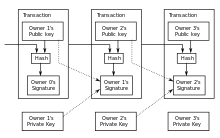
.jpg)


